#I like the way many masters sounds as shorthand
Text
Worldbuilding My Magic System FOR REAL
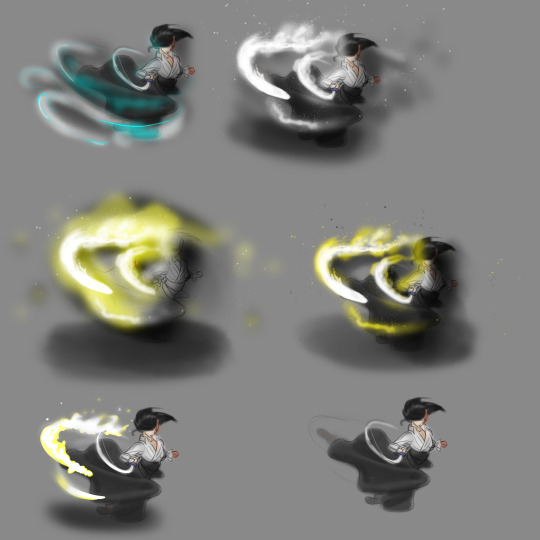
So Yssaia has HAD a pretty developed magic system for a while. And to recap it for you... I'm going to paste my half of me raving about this on Discord (thank you to @zebee-nyx and @galacticsand and @reaperofcrows for being so cool and letting me be an unhinged worldbuilding mad lad XD):
"What is Ysse?"
So the way Ysse works is its basically invisible dust floating in the air. And if it hits itself at certain velocities and in certain volumes, "spontaneous effects" happen -- like water materializing out of "nowhere" or fire exploding or wind gusts. You're limited a little by Avatar Last Airbender bending logic (you can't summon fully sapient creatures, you can't teleport, you can't control people's minds unless you're like... touching their nervous system, etc.)
So Mages invented the first writing as a way to record what patterns of movement did what. And eventually, used them to communicate these patterns as a shorthand for more generalized concepts...
So writing also got invented sometimes BEFORE agriculture...
"How precise do these movements/velocities need to be?"
It needs to be PRETTY precise. And this is why the average person CAN'T learn magic -- because Ysse in low amounts is invisible to the average person
But mages can see Ysse, which helps a lot. And they can see these shapes OCCURING in the natural world too -- when the wind blows, its because Ysse particles FORMED the Wind Rune/Sigil in the sky BUT this still doesn't guarantee that they cast any spells if they don't have the physical discipline too
So, in theory, "anyone" COULD move their hands PERFECTLY to spontaneously start a fire. But they PROBABLY won't
"How does this impact the natural world?"
This is also how animals and plants can do magic too. Tree roots in the north have roots that have specific patterns that warm up the soil, so snow can actually MELT and give them water and the tree doesn't die
And this is also my excuse for why so many things have bunny ears -- normally, long ears in colder-than-average climates (i.e. All of Yssaia) would be bad. But in Yssaia, these long ears are convergently evolving to channel Ysse. What they channel, exactly, I haven't decided (probably heat lol or something to increase air density so sound travels farther???)
AND all this is ALSO why the Demons are such an abomination -- because their Blood Magic doesn't obey particle physics, they just fucking do whatever they want
"Why do you need to know all this?"
The question at this point, I guess, is basically "How do I make fantasy technology that looks whimsical but also looks at least hypothetically functional under closer scrutiny?"
Yeah, and the full Answer TM to that right now is just <insert the entire design philosophy I haven't discovered yet here>
"So how IS magic going to shape technology, when you design it for the Untitled Yssaia Video Game?"
...Yeah, okay, after brainstorming all this, I think here's my strategy for how I'm going to tackle technology:
Step 2) Create a master list of technologies I will worry about/actually visualize in the game
I will want to keep an OPEN LIST so I can add more things to it as I do research/find really specific use cases (such as scrollcases or chopstick holders)
Step 1) Establish symbols for a handful of common things in both the North and the South that at least vaguely make sense with the concept of the particles.
So things like:
- Fire/Heat
- Water/Melt
- Ice/Slow
- Wind/Quicken
- Earth/Apply Force
- Sun/Light
- Moon/Closing/Locking (Thanks to @zebee-nyx for this one!)
Step 3) Design simple sprites for things that can later be shrunk down and used as set-dressing for maps BUT at a little bigger in scale so they can be shown to other people sensibly (maybe on the same sheet at the walking animations for scale?)
AND WITH THAT, after 5 years of only vaguely imagining all this, this is what I designed, using a combination of symbols I had already designed and dice that I pushed around on my desk to see what kind of patterns they'd make:
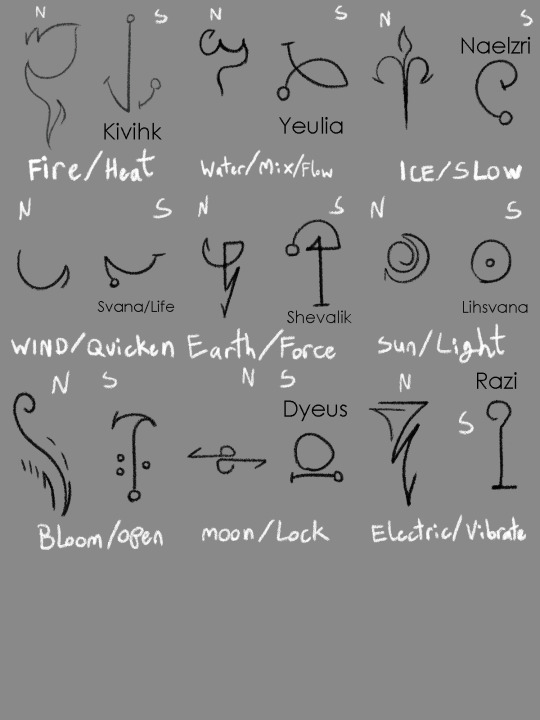
Are some of these a little funky and don't really work with real particle physics? Yeah, fair. I'll take notes, if you got 'em. I'm open to critique, if you wanna lol
Last comment that didn't make it into the big discussion with my buds tonight: Ysse particles are how temperature is distributed. So, hot areas have fewer, cold areas have more. I know that isn't how thermodynamics work but does anyone else really?
(Something something eldritch horror thermodynamics post... And my magic-god is an eldritch horror! See? It's perfect!)
Thank you for coming to my #WorldbuildingWednesday post! If you liked this, don't forget to REBLOG and follow the #Yssaia tag or something🥰 (Are calls-to-action cringe? Publicly shame me, if so)
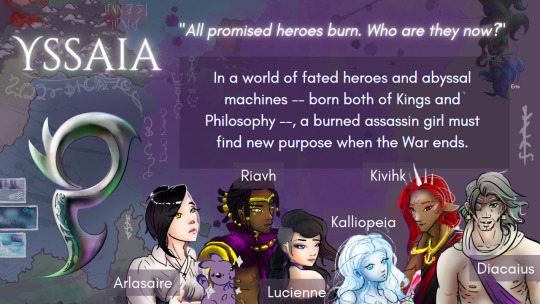
#worldbuilding#world building#world building wednesday#fantasy world building#magic system#magic#game dev#writing#amaiguri#yssaia
13 notes
·
View notes
Text
THIS IS WATER
by David Foster Wallace
There are these two young fish swimming along, and they happen to meet an older fish swimming the other way, who nods at them and says, “Morning, boys, how’s the water?” And the two young fish swim on for a bit, and then eventually one of them looks over at the other and goes, “What the hell is water?”
If at this moment, you’re worried that I plan to present myself here as the wise old fish explaining what water is to you younger fish, please don’t be. I am not the wise old fish. The immediate point of the fish story is that the most obvious, ubiquitous, important realities are often the ones that are the hardest to see and talk about. Stated as an English sentence, of course, this is just a banal platitude — but the fact is that, in the day-to-day trenches of adult existence, banal platitudes can have life-or-death importance. That may sound like hyperbole, or abstract nonsense. A huge percentage of the stuff that I tend to be automatically certain of is, it turns out, totally wrong and deluded. Here’s one example of the utter wrongness of something I tend to be automatically sure of: Everything in my own immediate experience supports my deep belief that I am the absolute center of the universe, the realest, most vivid and important person in existence. We rarely talk about this sort of natural, basic self-centeredness, because it’s so socially repulsive, but it’s pretty much the same for all of us, deep down. It is our default-setting, hard-wired into our boards at birth. Think about it: There is no experience you’ve had that you were not at the absolute center of. The world as you experience it is right there in front of you, or behind you, to the left or right of you, on your TV, or your monitor, or whatever. Other people’s thoughts and feelings have to be communicated to you somehow, but your own are so immediate, urgent, real — you get the idea. But please don’t worry that I’m getting ready to preach to you about compassion or other-directedness or the so-called “virtues.” This is not a matter of virtue — it’s a matter of my choosing to do the work of somehow altering or getting free of my natural, hard-wired default-setting, which is to be deeply and literally self-centered, and to see and interpret everything through this lens of self.
People who can adjust their natural default-setting this way are often described as being “well adjusted,” which I suggest to you is not an accidental term.
Given the triumphal academic setting here, an obvious question is how much of this work of adjusting our default-setting involves actual knowledge or intellect. This question gets tricky. Probably the most dangerous thing about college education, at least in my own case, is that it enables my tendency to over-intellectualize stuff, to get lost in abstract arguments inside my head instead of simply paying attention to what’s going on right in front of me. Paying attention to what’s going on inside me. As I’m sure you guys know by now, it is extremely difficult to stay alert and attentive instead of getting hypnotized by the constant monologue inside your own head. Twenty years after my own graduation, I have come gradually to understand that the liberal-arts cliché about “teaching you how to think” is actually shorthand for a much deeper, more serious idea: “Learning how to think” really means learning how to exercise some control over how and what you think. It means being conscious and aware enough to choose what you pay attention to and to choose how you construct meaning from experience. Because if you cannot exercise this kind of choice in adult life, you will be totally hosed. Think of the old cliché about “the mind being an excellent servant but a terrible master.” This, like many clichés, so lame and unexciting on the surface, actually expresses a great and terrible truth. It is not the least bit coincidental that adults who commit suicide with firearms almost always shoot themselves in the head. And the truth is that most of these suicides are actually dead long before they pull the trigger. And I submit that this is what the real, no-bull- value of your liberal-arts education is supposed to be about: How to keep from going through your comfortable, prosperous, respectable adult life dead, unconscious, a slave to your head and to your natural default-setting of being uniquely, completely, imperially alone, day in and day out.
That may sound like hyperbole, or abstract nonsense. So let’s get concrete. The plain fact is that you graduating seniors do not yet have any clue what “day in, day out” really means. There happen to be whole large parts of adult American life that nobody talks about in commencement speeches. One such part involves boredom, routine, and petty frustration. The parents and older folks here will know all too well what I’m talking about.
By way of example, let’s say it’s an average day, and you get up in the morning, go to your challenging job, and you work hard for nine or ten hours, and at the end of the day you’re tired, and you’re stressed out, and all you want is to go home and have a good supper and maybe unwind for a couple of hours and then hit the rack early because you have to get up the next day and do it all again. But then you remember there’s no food at home — you haven’t had time to shop this week, because of your challenging job — and so now after work you have to get in your car and drive to the supermarket. It’s the end of the workday, and the traffic’s very bad, so getting to the store takes way longer than it should, and when you finally get there the supermarket is very crowded, because of course it’s the time of day when all the other people with jobs also try to squeeze in some grocery shopping, and the store’s hideously, fluorescently lit, and infused with soul-killing Muzak or corporate pop, and it’s pretty much the last place you want to be, but you can’t just get in and quickly out: You have to wander all over the huge, overlit store’s crowded aisles to find the stuff you want, and you have to maneuver your junky cart through all these other tired, hurried people with carts, and of course there are also the glacially slow old people and the spacey people and the ADHD kids who all block the aisle and you have to grit your teeth and try to be polite as you ask them to let you by, and eventually, finally, you get all your supper supplies, except now it turns out there aren’t enough checkout lanes open even though it’s the end-of-the-day-rush, so the checkout line is incredibly long, which is stupid and infuriating, but you can’t take your fury out on the frantic lady working the register.
Anyway, you finally get to the checkout line’s front, and pay for your food, and wait to get your check or card authenticated by a machine, and then get told to “Have a nice day” in a voice that is the absolute voice of death, and then you have to take your creepy flimsy plastic bags of groceries in your cart through the crowded, bumpy, littery parking lot, and try to load the bags in your car in such a way that everything doesn’t fall out of the bags and roll around in the trunk on the way home, and then you have to drive all the way home through slow, heavy, SUV-intensive rush-hour traffic, etcetera, etcetera.
The point is that petty, frustrating crap like this is exactly where the work of choosing comes in. Because the traffic jams and crowded aisles and long checkout lines give me time to think, and if I don’t make a conscious decision about how to think and what to pay attention to, I’m going to be pissed and miserable every time I have to food-shop, because my natural default-setting is the certainty that situations like this are really all about me, about my hungriness and my fatigue and my desire to just get home, and it’s going to seem, for all the world, like everybody else is just in my way, and who are all these people in my way? And look at how repulsive most of them are and how stupid and cow-like and dead-eyed and nonhuman they seem here in the checkout line, or at how annoying and rude it is that people are talking loudly on cell phones in the middle of the line, and look at how deeply unfair this is: I’ve worked really hard all day and I’m starved and tired and I can’t even get home to eat and unwind because of all these stupid god-damn people.
Or, of course, if I’m in a more socially conscious form of my default-setting, I can spend time in the end-of-the-day traffic jam being angry and disgusted at all the huge, stupid, lane-blocking SUV’s and Hummers and V-12 pickup trucks burning their wasteful, selfish, forty-gallon tanks of gas, and I can dwell on the fact that the patriotic or religious bumper stickers always seem to be on the biggest, most disgustingly selfish vehicles driven by the ugliest, most inconsiderate and aggressive drivers, who are usually talking on cell phones as they cut people off in order to get just twenty stupid feet ahead in a traffic jam, and I can think about how our children’s children will despise us for wasting all the future’s fuel and probably screwing up the climate, and how spoiled and stupid and disgusting we all are, and how it all just sucks, and so on and so forth…
Look, if I choose to think this way, fine, lots of us do — except that thinking this way tends to be so easy and automatic it doesn’t have to be a choice. Thinking this way is my natural default-setting. It’s the automatic, unconscious way that I experience the boring, frustrating, crowded parts of adult life when I’m operating on the automatic, unconscious belief that I am the center of the world and that my immediate needs and feelings are what should determine the world’s priorities. The thing is that there are obviously different ways to think about these kinds of situations. In this traffic, all these vehicles stuck and idling in my way: It’s not impossible that some of these people in SUV’s have been in horrible auto accidents in the past and now find driving so traumatic that their therapist has all but ordered them to get a huge, heavy SUV so they can feel safe enough to drive; or that the Hummer that just cut me off is maybe being driven by a father whose little child is hurt or sick in the seat next to him, and he’s trying to rush to the hospital, and he’s in a way bigger, more legitimate hurry than I am — it is actually I who am in his way. Or I can choose to force myself to consider the likelihood that everyone else in the supermarket’s checkout line is just as bored and frustrated as I am, and that some of these people probably have much harder, more tedious or painful lives than I do, overall.
Again, please don’t think that I’m giving you moral advice, or that I’m saying you’re “supposed to” think this way, or that anyone expects you to just automatically do it, because it’s hard, it takes will and mental effort, and if you’re like me, some days you won’t be able to do it, or you just flatout won’t want to. But most days, if you’re aware enough to give yourself a choice, you can choose to look differently at this fat, dead-eyed, over-madelady who just screamed at her little child in the checkout line — maybe she’s not usually like this; maybe she’s been up three straight nights holding the hand of her husband who’s dying of bone cancer, or maybe this very lady is the low-wage clerk at the Motor Vehicles Dept. who just yesterday helped your spouse resolve a nightmarish red-tape problem through some small act of bureaucratic kindness. Of course, none of this is likely, but it’s also not impossible — it just depends on what you want to consider. If you’re automatically sure that you know what reality is and who and what is really important — if you want to operate on your default-setting — then you, like me, will not consider possibilities that aren’t pointless and annoying. But if you’ve really learned how to think, how to pay attention, then you will know you have other options. It will actually be within your power to experience a crowded, loud, slow, consumer-hell-type situation as not only meaningful but sacred, on fire with the same force that lit the stars — compassion, love, the sub-surface unity of all things. Not that that mystical stuff’s necessarily true: The only thing that’s capital-T True is that you get to decide how you’re going to try to see it. You get to consciously decide what has meaning and what doesn’t. You get to decide what to worship…
Because here’s something else that’s true. In the day-to-day trenches of adult life, there is actually no such thing as atheism. There is no such thing as not worshipping. Everybody worships. The only choice we get is what to worship. And an outstanding reason for choosing some sort of God or spiritual-type thing to worship — be it J.C. or Allah, be it Yahweh or the Wiccan mother-goddess or the Four Noble Truths or some infrangible set of ethical principles — is that pretty much anything else you worship will eat you alive. If you worship money and things — if they are where you tap real meaning in life — then you will never have enough. Never feel you have enough. It’s the truth. Worship your own body and beauty and sexual allure and you will always feel ugly, and when time and age start showing, you will die a million deaths before they finally plant you. On one level, we all know this stuff already — it’s been codified as myths, proverbs, clichés, bromides, epigrams, parables: the skeleton of every great story. The trick is keeping the truth up-front in daily consciousness. Worship power — you will feel weak and afraid, and you will need ever more power over others to keep the fear at bay. Worship your intellect, being seen as smart — you will end up feeling stupid, a fraud, always on the verge of being found out. And so on. Look, the insidious thing about these forms of worship is not that they’re evil or sinful; it is that they are unconscious. They are default-settings. They’re the kind of worship you just gradually slip into, day after day, getting more and more selective about what you see and how you measure value without ever being fully aware that that’s what you’re doing. And the world will not discourage you from operating on your default-settings, because the world of men and money and power hums along quite nicely on the fuel of fear and contempt and frustration and craving and the worship of self. Our own present culture has harnessed these forces in ways that have yielded extraordinary wealth and comfort and personal freedom. The freedom to be lords of our own tiny skull-sized kingdoms, alone at the center of all creation. This kind of freedom has much to recommend it.
But of course there are all different kinds of freedom, and the kind that is most precious you will not hear much talked about in the great outside world of winning and achieving and displaying. The really important kind of freedom involves attention, and awareness, and discipline, and effort, and being able truly to care about other people and to sacrifice for them, over and over, in myriad petty little unsexy ways, every day. That is real freedom. The alternative is unconsciousness, the default-setting, the “rat race” — the constant gnawing sense of having had and lost some infinite thing.
I know that this stuff probably doesn’t sound fun and breezy or grandly inspirational. What it is, so far as I can see, is the truth with a whole lot of rhetorical bullshit pared away. Obviously, you can think of it whatever you wish. But please don’t dismiss it as some finger-wagging Dr. Laura sermon. None of this is about morality, or religion, or dogma, or big fancy questions of life after death. The capital-T Truth is about life before death. It is about making it to 30, or maybe 50, without wanting to shoot yourself in the head. It is about simple awareness — awareness of what is so real and essential, so hidden in plain sight all around us, that we have to keep reminding ourselves, over and over: “This is water, this is water.”
It is unimaginably hard to do this, to stay conscious and alive, day in and day out.
7 notes
·
View notes
Text
I have written a pair of haxion brood bounty hunters named Big Bubba Kriffer and his partner Flakshaft.
#I needed to get in the ballpark of calling them 'Mother Fucker' and 'Fuckstick'#So here we are#jfo#to fall before we fly#tfbwf#I wish this fic abbreviated better#Heavenward shortened down to hwd so nicely#I like the way many masters sounds as shorthand#But tfbwf just sounds clumsy
4 notes
·
View notes
Text
FFXIV Write Entry #1: Delayed Gratification
Prompt: foster || Master Post || On AO3
IT BEGINS.
The Jewels and Java cafe is the brilliant brainchild of my friend @catpella and was used with permission. :3
--
“Again, I am so sorry,” Synnove hissed, mortified, as they walked down one of the many hallways of the Arcanists’ Guild.
“It’s perfectly all right, my love,” said Aymeric fondly, squeezing her hand. “If we miss the ferry, we can simply teleport.”
His lady sighed heavily and muttered, “But I like the ferry ride…”
He laughed and raised her hand to kiss her knuckles, and satisfaction purred in his chest at the way Synnove’s golden cheeks rosed with pleasure. Galette, in her usual position draped around her mama’s neck, didn’t bat an eye. Ivar, behind them, made a disgusted noise, followed soon after by Tyr’s annoyed elder brother huff; he ignored them, well used to Synnove’s sons’ idiosyncrasies.
It was not the first time one of their getaways had been temporarily delayed by a work-related emergency; their friends and colleagues were normally keen on ensuring the pair of them got to take vacations, but sometimes matters arose that absolutely could not be handled by anyone else. This one, thankfully, had occurred while they were still in the city and easy to reach. Very easy; they’d been merely around in the corner from Mealvann’s Gate in the Jewel and Java café, enjoying sweet treats before they planned to wander over to the ferry quay for the journey to Bloodshore and the cabin, when Thubyrgeim’s emerald carbuncle, Din, scurried in with a note from the Guildmistress.
“Oh, she’s playing dirty,” Synnove had muttered as she read the note. Din had twitched an ear in her direction, but he had clearly been in the midst of gossiping with Galette and Tyr, their noses and ears and tails moving in the way of creatures who didn’t need sound to communicate.
(Aymeric had, not for the first time, suspected that Synnove’s carbuncles’ aetheric harmonic matching capabilities were nowhere near as common as his lady implied they were. Certainly, he’d never ‘heard’ any other carbuncles speak, but he also knew Synnove’s quintet limited their direct communication to Synnove’s immediate social circle, and it would not be out of the realm of possibility that other carbuncles had similar preferences…)
Aymeric had peered over his shoulder, setting down his fork with its piece of rolanberry shortcake on his plate, and shook his head in amused exasperation at the sight of the Guildmistress’s shorthand, which was as atrocious as Synnove’s. “What seems to be the problem?”
“One of the fourth-years needs final approval for her thesis project’s spell changes,” she had said, refolding the paper, then pinching and dragging her nails along the crease to sharpen it. A chip of her bronze nail lacquer ended up left behind. “Yamomo—” the chair of the aetherophysics department, he had recognized the name immediately, “—had to ‘port out to the Range. It’s either an unscheduled detonation or one of the Squadrons fired on a part of the island they’re not supposed to, Thubyr’s writing got a bit sloppy there.”
A bit sloppy?
Pointedly ignoring his look, his lady had continued, “Solkthota’s presenting her thesis project at the next conference, and guess where that is?” Her voice had turned as dry as the Sagolii.
Aymeric had giggled even as he had fished Roksana out of her bowl of melting ice cream and absently began cleaning her face with a napkin as the white carbunclet had purred. “Does it start with ‘Radz’ and end with ‘Han,’ by chance?” he said.
“Oh, you’re good,” Synnove had said with a rueful laugh, and waved down one of the café’s waitresses to get their desserts packed to go.
Now, they approached one of the warded workrooms in the Guild’s north wing. As they did, Synnove carefully smoothed out her expression from huffy and annoyed to professional interest. For all that she did want to be vacation right now, enjoying the lazy trip around the southern coast of La Noscea to sightsee or nap or cuddle, she would never take out that frustration on one of her students.
She dropped his hand—reluctantly, though she quickly skimmed her thumb over his knuckles first—and opened the door to the workroom, stepping inside, with Aymeric following just at her heels.
The workroom was large and well-lit, the early afternoon sun streaming in through the many windows. The part they immediately walked into was a small observation area, with a setup of desks similar to a small amphitheater leading down to the main floor; this must be one of the practical demonstration workrooms, then. Two students were off to the side, a dark-skinned Highlander lad and a tiny grey elezen girl who had yet to hit her growth spurt and could have been anywhere between sixteen and twenty-one summers old. At the front of the workroom, pacing nervously, was a gangly Sea Wolf young woman, skin the color of storm clouds and hair such a shocking shade of daffodil yellow he would have thought it was dye if her eyebrows hadn’t been the same color.
All three students’ head whipped up and around when Synnove entered, and Aymeric saw the two sitting ones’ jaws drop as he took a seat at one of the other desks, Ivar and Tyr jumping into seats next to him as the twins tumbled down his arms to the desktop. The presumed Solkthota paled and stammered out, “Professor Greywolfe! You’re supposed to be on vacation—”
Synnove waved a hand and closed the short door on the partition between the observation area and the presentation area. (Briefly, as the latch on the door clicked into place, he felt the faint snap of a ward activating.) “Hadn’t left yet, Solk, and an emergency means Professor Yamo has to put the fear of the Twelve into someone,” she said absently. Her voice had gone from her usual faintly Ala Mhigan and Lominsan accented lilt into the crisp tones of a Gate arcanist on duty. “Remind me of what your thesis was covering? Professor Yamo hasn’t given me a copy yet.”
The young Sea Wolf took a deep breath and launched into a technical diatribe that almost immediately had Aymeric’s eyes glazing over. He recognized a few words and phrases—Shotamian manifold, harmonic oscillation—and knew just enough from listening to Synnove’s explanations over the years that this project didn’t seem to be carbuncle focused, but otherwise it was all Allagan to him. Instead, he made sure Amandina and Roksana hadn’t taken a page out of Galette’s playbook and hadn’t gotten into the bag of treats sitting beneath the desk at his feet, and leaned back in his seat to observe. Faintly, he could hear the other two students murmuring to one another, but about what, he was too far away to tell.
(They weren’t looking at him as they did, at least, so if he was the subject of their conversation, they at least had better manners about it than most Ishgardian nobles.)
Solkthota finished quickly, nerves clear as day on her face, and Synnove nodded, reaching up to pet Galette’s tails. “All right, no time like the present to test this.” She gestured towards one of the person-shaped targets at the end of the room. “Let’s see what this modified Ruin can do.”
The student took another breath as she unhooked her grimoire from her belt, opening it and quickly turning pages to the correct one. Solkthota removed her channeling stylus from the strap on the grimoire’s back and held it up in the air, the tip pointed towards the target, and began to cast.
The bolt of power had barely left the stylus before Synnove was roaring “DOWN!” and tackling the Sea Wolf to the floor. Aymeric grabbed the twins just as the word began to leave Synnove’s lips, and was on the floor beneath the heavy ironwood desk, the shrieking carbunclets tucked close to his chest, just as the echo of it was overtaken by the roar of an explosion. Tyr was on top of him and his little sisters as a bright light blinded him, blocking it out, but having an enormous topaz carbuncle atop him did nothing to muffle the sound or the feel of the room trying to shake apart.
The silence in the aftermath was nearly as deafening as the explosion had been.
Tyr rolled off his head, shoving past Ivar, who hung from the desk, chittering in excitement because big boom and, of course, he had watched. Aymeric crawled out after Tyr, and as he stood, the girls immediately pulled themselves up onto his shoulders and tucked into his neck, shivering. He absently stroked first Roksana, then Amandina, and hurried to the other end of the observation area to where the other students had been. As he walked, he noted that the ward on the partition was flickering oddly, like cracked glass, but the spell still held—barely.
The Highlander boy had covered his elezen classmate’s head with his torso, and she was shoving at him now, her voice muffled by his bulk, saying, “Tyon, gerroff, you’re heavy!”
Aymeric bent over to help Tyon keep his balance as he pushed himself up and crawled out from the desk. “Are you all right, you two?” he said.
Tyon rubbed at one ear, and accepted his proffered hand to get to his feet. “Ears’re ringing,” he said while also blinking rapidly. His tiny classmate popped up next to him, patting her dark blue hair back into place and scowling faintly.
Synnove, meanwhile, was lowering her arm; the right one, upon which she wore the ring denoting her as a master arcanist. The glimmer of a shield fell away as she did, and then she was standing upright and helping Solkthota to her feet. Galette’s ears were pinned back and her nose was twitching, but otherwise she seemed utterly unperturbed.
“I am so, so sorry,” the Sea Wolf was saying, her whole body shaking and her eyes wide with mixed shock and horror. “I know I did the math right, I know I did—”
“Honey, take a deep breath,” Synnove interrupted, hands on Solkthota’s shoulders and her voice firm as she looked up at the young woman. “In for seven, and hold, hold, hold, little more, and now out for seven. That’s it. And again…”
As Synnove calmed her student, Aymeric and the other two began righting chairs and wiping plaster dust from the tops of the desk. Tyr came over to headbutt Tyon’s thigh, and the Highlander gave his head a firm rub; as he did, an emerald carbuncle that appeared more vulpine than the standard manifested, yipped what was likely a hello, and then went to sit on the elezen girl’s foot. She immediately bent down and scooped the creature into her arms, tickling under its chin.
Soon enough, Solkthota’s breathing was under control, and Synnove gave her a grin. “There we are. Now, what’s the first rule of science?”
Solkthota’s answering grin was shy and watery. “It’s not science until you write it down.”
“Very good,” said Synnove, her green eyes glittering. “So let’s do that first. Next, we’re going to go through your arrays page by page; your working theory is sound, but the math fell through at some point.” She suddenly pointed towards the young elezen, without looking. “And no helping her, Atreanne!”
“Oh, come on, Professor G!” Atreanne said in a high, nasally whine. Her carbuncle added its own whine as emphasis. “I’m the best at it!”
“And Solkthota will learn better if you don’t feed her the answers,” Synnove said, her voice wry in the way of someone who had. “But you and Tyon are welcome to stay and observe, both of your physics work could do with some polishing.”
Tyon and Atreanne exchanged looks, wide-eyed, and then bolted for the partition.
“I’m glad now it wasn’t Professor Y today,” Aymeric heard Atreanne whisper to Tyon. “Professor G’s way more patient with screw-ups.”
“Professor G likes screw-ups,” Tyon whispered back. “They’re more fun, she says.”
“They are more fun, now hop to it, kids!”
Solkthota was dragging over the desk that had been pushed up against a wall, and Tyon and Atreanne grabbed chairs from the observation to bring over and sit with their classmate and teacher. Synnove, meanwhile, looked at Aymeric as she walked backwards towards the slate chalkboard.
“Can you get me some fresh chalk?” she said, a rueful grin on her face.
Aymeric laughed and gave her a sweeping bow, the twins peeping excitedly as they held on. He righted them as he straightened, and turned to head to where he knew one of the storage rooms were.
It was a good thing he had remembered to pack a few books to read.
#ffxivwrite2021#final fantasy xiv#ffxiv#aymeric de borel#aymeric x wol#aymeric x synnove#oc: synnove greywolfe#synnove's carbuncles#dt's writing
45 notes
·
View notes
Note
"I would also like to go off about titles in daybreak too. Lady, lord, master, foreteller…. All very made up in the moment, but if you give it to kids and say that’s how it is, they’re going to make it real"
PLEASE GO OFF
H-CCOUUUUGHH HACK HACK COUGH
OKAY SO THERE ARe there are two ways, this can go. One thing we know for sure is Ava, at least, was close with her kids, or at the very least Ephemer. He chats with her very casually. Another thing we know is the Foretellers are not consistently Around, they’re rather secluded and rare to just encounter on the street. They are also pretty much given mastery over their unions, and the kids do what they say. Lady, Master, and Foreteller mean the same thing. So, what this means is, either the titles they receive as apprentices to the Master of Masters are for all intents and purposes decorative, or they aren’t. How did I extrapolate from those two points come on a journey with me that will not explain how I got there
AUGH AND I LOST A WHOLE DRAFT HERE BUT I’LL TRY TO REPLICATE IT BEST I CAN. OKAY SO THERE ARE TWO SCENARIOS HERE and the two can mix it’s not mutually exclusive in here. Scenario 1. The titles are decorative. the foretellers know or know of basically every kid in their unions, they know their strengths and battle prowess and weaknesses and quirks. Ava is the leader, her name is Lady Ava, but it’s Lady Ava to distinguish her from Ava the 14 year old in Ursus. They lead in like… a camp counselor way. Advice, rallying, etcetcetc. Teachers. When Daybreak falls, Ephemer and the survivors build Scala out of the same basic structure. They see, though, the ruin that unions brought, so they change unions PLURAL to union SINGULAR, creating like… a monarchy, not a plutarchy. Ephemer leads the kids like Ava would. The aggregate citizens of Scala carry this on and extrapolate from it. Mastery is the highest rank, often accompanied by a title or an epithet to designate you master (think professors). So, Aqua could technically choose to be called Lady Aqua. However, Ephemer’s mastery lineage remains in power. Keyblade succession follows this rule, passed down from Master to apprentice if the Keyblade so chooses to persist. “Blueblood” is shorthand for… basically who Blaine’s keyblade has chosen to be next, avatar style.
scenario 2. The titles are given more weight. There are simply too many kids, Lord Ira cannot hope to know them all. They’re like the professors of those huge auditorium classes, or like enigmatic and mysterious leaders who give out tasks and promise rewards, increasingly against the other leaders’. Who knows where they are, or what they plan to do, but we know they’re powerful, and we know they know more than us, they’re called foretellers. My union leader taught me this — he taught me this. Thus, the kids learn to tie the titles and the masks and the knowledge and the mastery to each other in a bundle. They basically make knights’ oaths without even realizing that’s what theyre doing. When they make it to Scala, Ephemer is the only one in that spot, the only one who really truly knows everything — so whether he wants it or not, he’s getting a rank, and a title, and a statue. that’s just how they live, and Ephemer needs to give them SOME structure, or those poor kids will fall apart. It’s not bad, it’s gentle. He takes that responsibility, just like he already did once. Scala carries it on, and keeps going. In a divine souls sort of way, Lineage, not succession, is the way the ““monarch”” is chosen. Familial line becomes tied in with that whole bundle too, and the Keyblade stays in the family.
this is all. Very much heavier based on how the keyblade’s purpose is to maintain balance in the worlds. It’s such a weighty purpose. Wouldn’t it be easier to have someone shoulder that burden, and you just help then any way you can? Have one person, or a set of people, who can think about that for you? They, those who know, they have the right to direct. I think Scala started to go brrrooooo with that idea. Masters and Apprentices, yes — plenty of those. Teachers and students. All under… something. Some aggregate of things. Something tangible to be loyal to. Seekers are just masters who chose not to teach, to research instead (Scala Really is just dark academia), Masters are just professors, SOMEONE is in charge.
and thus the title system becomes a way to distinguish rank in the Literal way, not just the flippant way. Daybreak would function like we functioned playing it — missions are missions from Lord Gula. Dailies are dailies if you want to stay on top. Union rankings are important. They’re the same things, but with completely different vibes. Either the kids were going along with the war because what else would they do, or they were going along with it because what else would they do but follow yknow
if Scala extrapolates on this teaching, ostensibly made up by the Master and then carried on because they didn’t really know any other kind of societies, they can take it a more casual way or a more rigid way, basically. And I think they took it more rigidly. But Scala isnt important here actually Daybreak is as THEYRE the nexus of creating this odd new system where Everyone has this responsibility to the universe and a soul weapon and magic right. If I’m a kid promising a foreteller I will do anything to keep the light safe and collect Lux for you, Master Invi, whatever you ask of me, and she says good job, you’re a good student, there ought to be more keybearers as upright as you. What do you think that’ll do.
TO SAY NOTHING OF THE MORAL ABSOLUTISM THE FORETELLERS ARE SO FOND OF PREACHING and which MUST extend into dark road seeing as Eraqus is allowed to be Like That and Xehanort’s much more moderate take is kind of perceived as iffy. Even tho the narrative is like ( :/ hes got a point). If THEYRE right, and you my child can be wrong but if you follow you can be right too. tell me that doesn’t sound like a hotbed for the birth of paladins come on . mom wants some paladins. eraqus is just a case of deep rooted That.
anyways Um. pay me to write fake history and anthropology books about fake places but don’t actually because they will not have correct grammar
#OH BOY YOU ARE ALL JUST. LETTING ME GO GET CHECK OUT HOW HARD I CAN TALK FWWSSSSHHHHHHHHHH#AH. THANKS? YES.#long post#kipspeak#kh#KHUX JUST PUT THESE THERE AND SAID GO FETCH AND I WENT HHHHH#This is very stream of consciousness but basically#either we are casual or we are not with this society scaffolding#and I don’t think we were casual towards the end of it at least#I think the beginning was chill. But the war and the dandelions and……. All that……
59 notes
·
View notes
Text
Hellsing Liveblog Ch. 68-69 (nice)
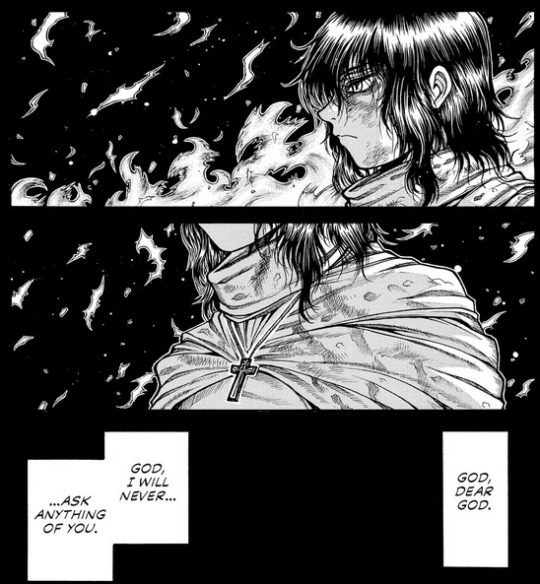
This is the “Castlevania” arc. It’s only two parts, but I want to slow down and take my time with this one.
Okay, so in the last chapter, Alucard was fighting Alexander Anderson, who used one of the nails from the True Cross to pierce his own heart, which transformed Anderson into some sort of miraculous creature made of thorny tendrils. Then he struck a heavy blow on Alucard’s head, and just sort of kept on going down his neck and chest.
And as far as we call tell, this is the most danger Alucard’s been in since the story began. Anderson lopped off his head in their first encounter, and even that didn’t stop him. Now, in this “holy monster” form, Anderson can grow back body parts just as easily as Alucard, and he seems to be able to hurt Alucard a lot more than ever before. The irony is that Alucard might have been honored to lose to Anderson, but only when he was a human foe. Now that Anderson has used the Nail of Helena to become something inhuman, Alucard feels that it diminishes their fight.
Regardless, Alucard is in serious danger, or so it seems. Even his horde of familiars are bursting into flames all around him, which I assume is a side-effect of Anderson’s attack. As this happens, Alucard appears to lose consciousness, and flashes back to his childhood.
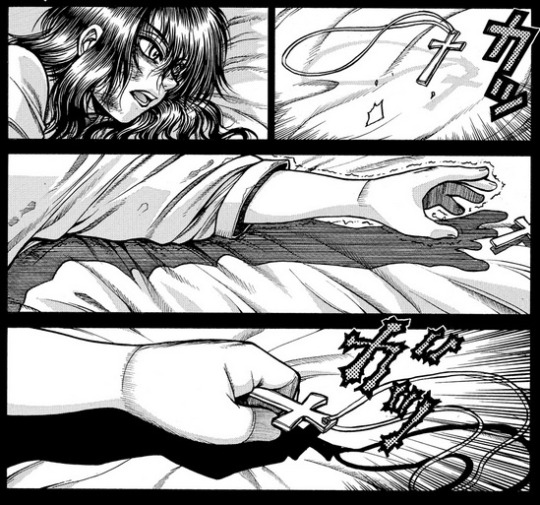
This whole flashback seemed like a nonsequitur to me when I watched the Hellsing Ultimate OVA, but I think it makes a bit more sense this time around. As a boy in the 1440′s, Vlad Tepes was something of a religious fantatic, much like Father Anderson in 1999. He pledged to never ask God for anything, which I don’t think is theologically sound, but let’s run with it. The point here seems to be that Vlad felt it was more pious to endure hardship while keeping his faith in God.
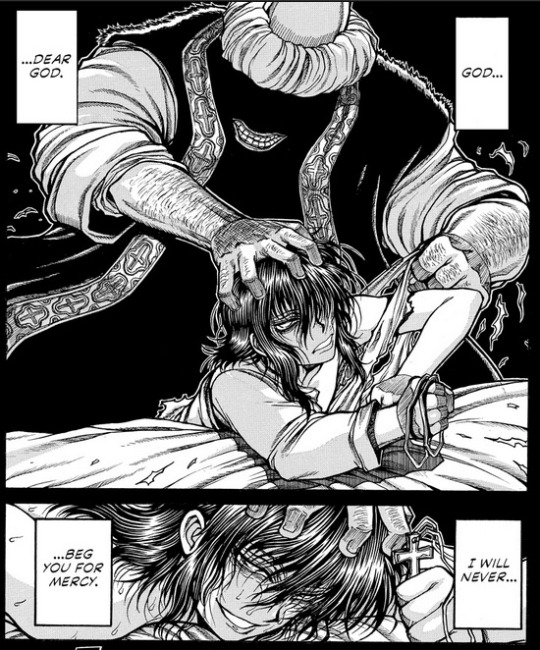
For example, in this scene, we see Vlad being dragged away to be raped, and he grabs the cross he wears around his neck for solace. He doesn’t beg God for mercy or deliverance, but simply clings to his faith to see him through.
I’m assuming the man in shadow is Sultan Murad II of the Ottoman Empire. In 1442, Murad summoned Vlad’s father to Gallipoli, and he went there with Vlad and his brother Ruda. The Sultane then imprisoned all three of them, and eventually released Vlad’s father, but kep the boys as hostages to ensure the fahter’s loyalty. There was a period when Vlad’s father sided against the Ottomans, and he presumed his sons had been killed, but in fact they survived and eventually returned to Wallachia. So maybe Kouta Hirano is taking some creative license here, and suggesting that Murad II took out his anger on Vlad in other ways.

Eventually, Vlad became the Voivoide of Wallachia, and in this flashback we find that he considers fighting to be a form of prayer. Not for mercy, because Vlad refuses to ask for that. Instead, he seems to believe that if you just keep fighting hard enough, God will descend from the heavens. None of this made sense to me the first time around, but once you start interpreting this in the context of Vlad as a religious extremist, it starts to add up. Anderson’s fellows in the Iscariot Organization were literally blowing themselves up to help Anderson defeat Alucard, and they were happy to do it, because they saw it as a holy mission. Anderson himself was eager to use the Nail to make himself into a monster, because he craved to be a single-minded instrument of God’s will. A righteous bludgeon to smite the wicked. Vlad Tepes’ “bloodlust” seems to have been inspired by a similar zealotry, at least as Hirano sees it.

But in the end, did God descend to respond to Vlad’s “prayers”? The image of the modern Alucard is all the answer we need. Of course that didn’t happen.

I’m just cribbing from the Vlad the Impaler page on Wikipedia, but from what I gather about Vlad’s final years, he was fighting for the office of Voivoide of Wallachia against Basarab Laiotă , who had support from the Ottoman Empire. Vlad fought and lost, probably dying in battle in December 1476/Janury 1477. The story goes that his corpse was cut into pieces, and his head sent to Ottoman Sultan Mehmed II.
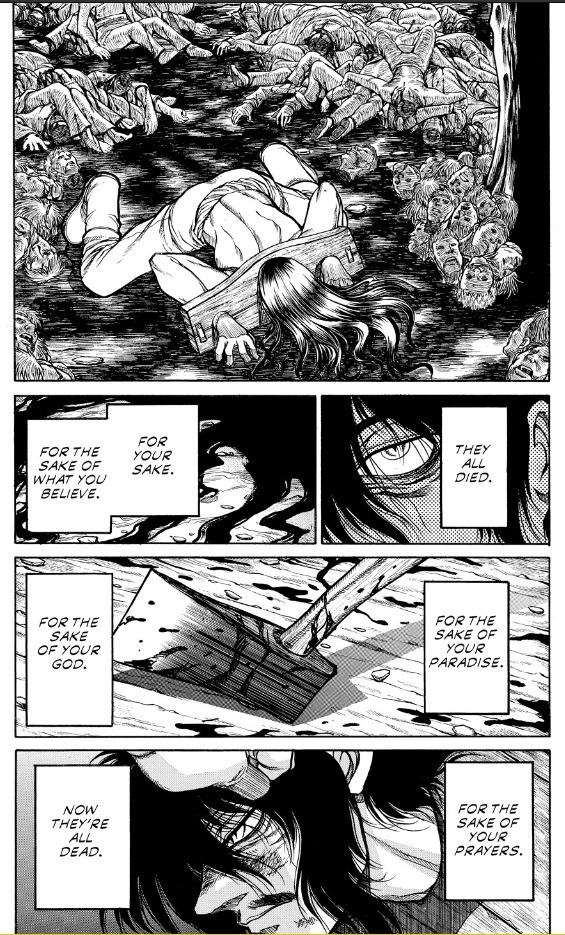
So Kouta Hirano depicts Vlad’s final moments with him being captured and executed. This is certainly plausible, and it gives Vlad a chance to reflect on his failure before he meets his fate. He fought and killed so many people, daring to resist the Ottomans even as he ruled a state that was basically controlled by the Ottomans, and I guess he must have known how impossible that would be, which is why he counted on God to deliver him, so long as he fought hard enough.
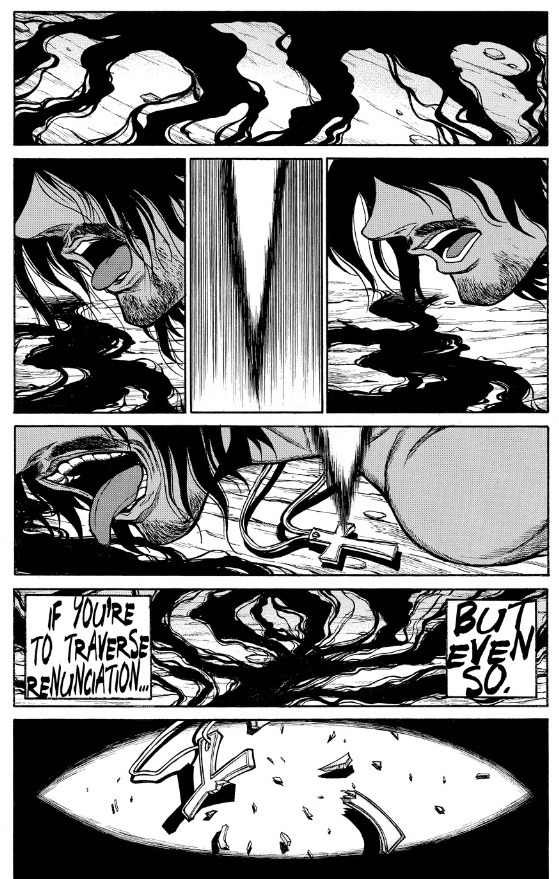
But in that final moment, just as the axe comes down on his neck, he still has his cross... but instead of taking solace in that, he reaches out instead for the puddle of blood in front of him. The axe comes down and shatters the cross, just as Vlad Tepes forsakes his humanity.
So maybe all of this is a way of Alucard accepting defeat. Defeated and humbled, no longer a servant of God or a leader of men, no longer even a man, he renounced his faith and became the vampire Dracula, and eventually Alucard. But now Anderson seems to have the upper hand, so maybe, after 523 years, Vlad Tepes is back where he started, facing an inevitable death.
And you know, maybe Anderson’s monster form represents the divine intervention he was waiting for back in the 15th Century. After all these centuries of battle, you might say that God finally did descend from heaven to respond to Alucard. So maybe this is a fitting swan song for the guy. He wanted to die at the hands of a human adversary, but maybe this works too, right?
But then he hears someone calling out to him, and...
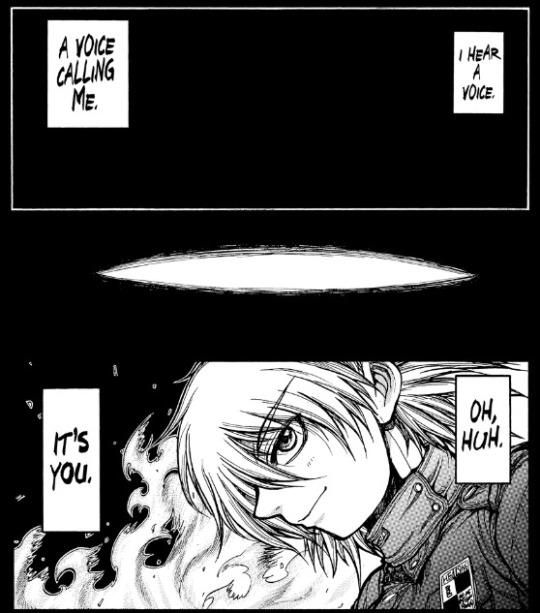
Hey, it’s Seras!

So yeah, we’re back to the real world, and Anderson’s well on his way to chopping Alucard in half and burning him with holy fire or something...

And Alucard’s still out of it...

And then Seras jumps in to save his ass! Cool!
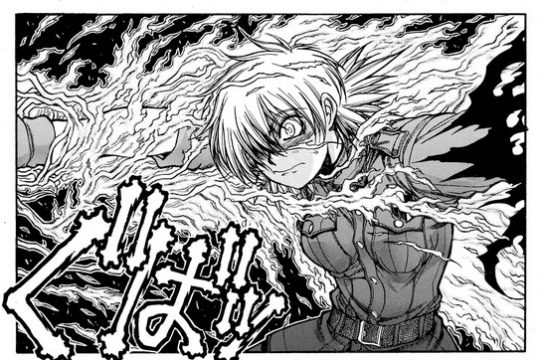
The only problem is that this was killing Alucard, and Seras is less powerful than Alucard, so she’s probably not going to be able to do a lot of good here. For that matter, this might just get both of them killed.
And this is why I think this moment is cool. When Team Four Star did their Abridged parody of Hellsing, they sort of skipped this whole “Seras jumps in” part of the fight. Instead, they did a whole thing where Alucard has a near-death experience and talks to God. Then he rejects God’s offer of forgiveness and goes on to defeat Anderson by himself. I don’t care much for that, because Seras is my favorite character, and I find the whole routine of “Well maybe I don’t need your forgiveness, God!” kind of stale and limp. Can something be stale and limp at the same time?
Like, I think I get that a lot of atheists are sore at the whole “organized religion” thing, but it seems kind of silly to write a whole bit where the premise is that God is real, but only so we can all tell him to get lost. Like, I’m a Christian, so I can’t really relate, but if I thought God didn’t exist, I wouldn’t spend all day writing angry text messages to God to remind him of how fake he is.
But mostly, I just really like Seras, and this is a cool Seras scene, and I think that deserves attention, so here we are.
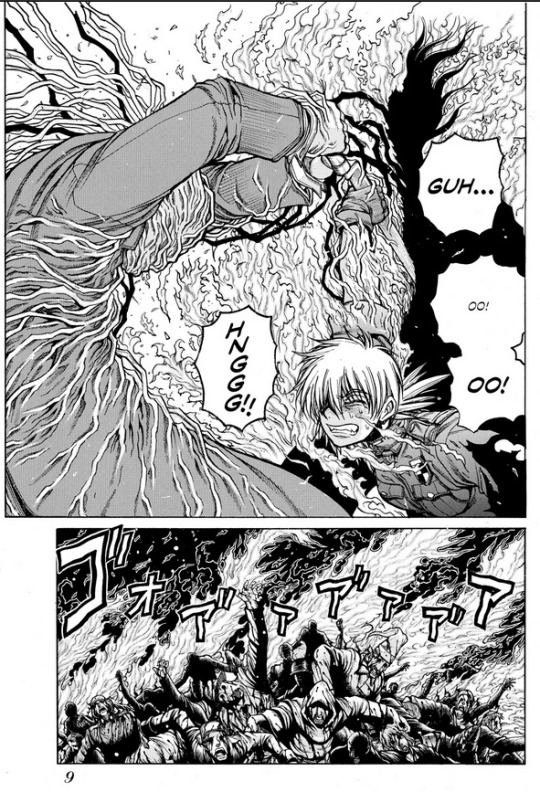
The Alucard-Seras relationship is complex by design. With Integra and Alucard, there’s not much to it. She literally addresses him as “slave” at one point, and he repeatedly talks about himself like a weapon that she has to point at her target. There’s something kind of like that with Al and Seras. In one of their first missions together, he sends her to take out a bunch of ghouls just so he won’t be bothered, and it’s almost like he’s weilding her as a weapon. But he also never leans on that too hard. For one thing, there’s not a whole lot of thngs Seras can do for him that he can’t do more easily himself.
It feels a lot more like a Master/Apprentice relationship, which may not strictly be a vampire thing, because he’s teaching her how to hunt vampires and how to be a vampire at the same time. I think Seras has the same sort of devotion to her master as he does for Integra, but that’s mostly overshadowed by a more down-to-earth respect and admiration. She sees him like a superior officer and a mentor, but she also knows that he has this strange charm over her that she can’t explain or resist.
One of the things I can’t stand about he Gonzoverse Hellsing Anime is how after a while they just started having Seras say “Master...!” over and over. I get it, there’s some power in the way she says it. It means a lot of things to her. I wouldn’t be shocked to find out that “Castlevania part 2″ inspired some of that, but I don’t know what chapter of the manga was published when the anime wrapped up. But it annoyed me that they just used “Master...!” over and over again as a shorthand for Seras’s feelings. You have to do something with it. Demonstrate it, like we’re seeing here with Seras trying to remove a blessed bayonet from Alucard’s torso. She has to help him, even if it means risking her own neck, because he means so much to her, and she wouldn’t be here without him. And yeah, she’s his vampire servant, so this seems like something a loyal servant should be doing. Stickin’ together is what good waffles do.
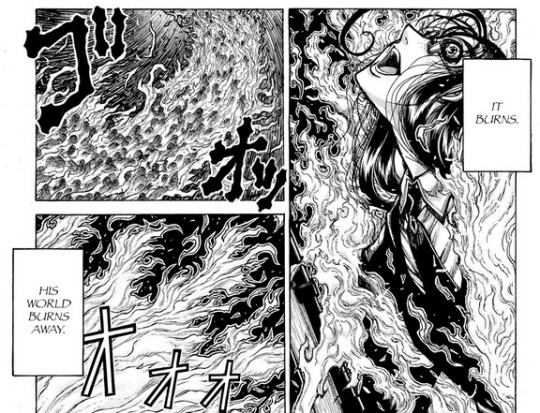
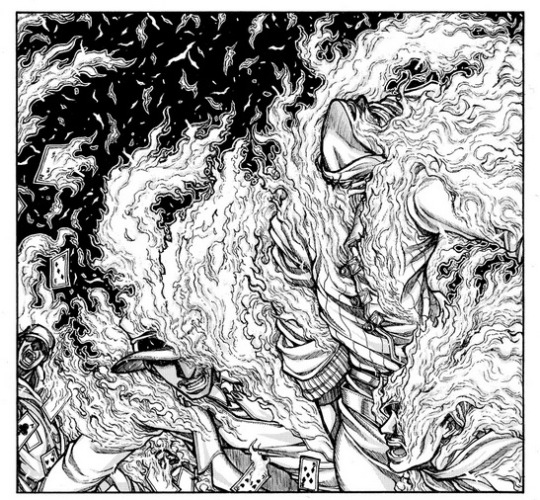
Let me pause here to note that this marks the destruction of whatever remained of Dandyman and Rip van Winkle, the only “name” characters featured in Alucard’s menagerie of absorbed souls. Whatever Anderson is doing to Alucard, it’s destroying them, irrevocably.
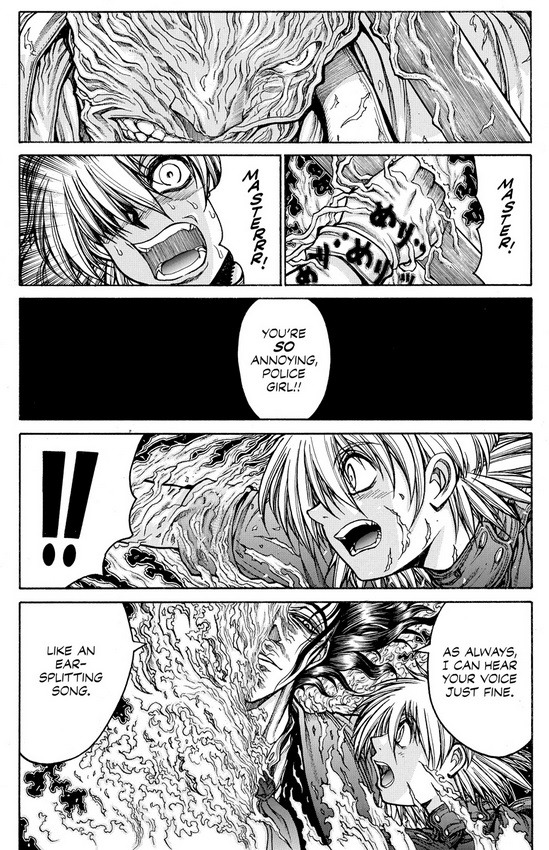
So it occurred to me one day, what if Seras has to save Alucard, not out of slavish devotion or plucky heroism, or even righteous loyalty? Way back in Chapter 1, Integra explained vampires to the local authorities, and said that when you kill a vampire, you also destroy all the ghouls and servant vampires that were created by that first vampire. In other words, if Alucard were to be destroyed, Seras ought to die with him. So maybe her efforts here could be nothing more than self-preservation. I’m not wild about that idea. Maybe, after drinking Pip’s blood, Seras “graduated” from that lowly status, and she no longer depends upon Alucard in this way.
But I think the point remains either way. They’re in this together. Alucard called the two of them a family, and it wasn’t just creepy vampire talk. There’s a bond between them, and it matters to both of them. And that’s why Seras’ intervention here is what brings Alucard back from the brink. By rushing in to help him, Seras has placed herself in danger, and now they have to rescue each other.

I like this part where he puts his hand on hers as they pull out the bayonet together. It’s like the moment when Seras reached out to Alucard in Cheddar and he took her hand then. Well, that was only in the OVA, but still.
Alucard tells Anderson that he might have welcomed a death like this, maybe back when he was about to get beheaded in 1476, but now, he refuses to be defeated. 523 years ago, he was at his lowest ebb. He had nothing. Today, he has Seras.
And... yeah, he has Integra too. I don’t want to dismiss the importance of that relationship. But Integra could find a way to get by without him if she needed to. He has a responsibility to Seras, though, and Seras’s loyalty trumps whatever death-fantasies he might have on his mind.
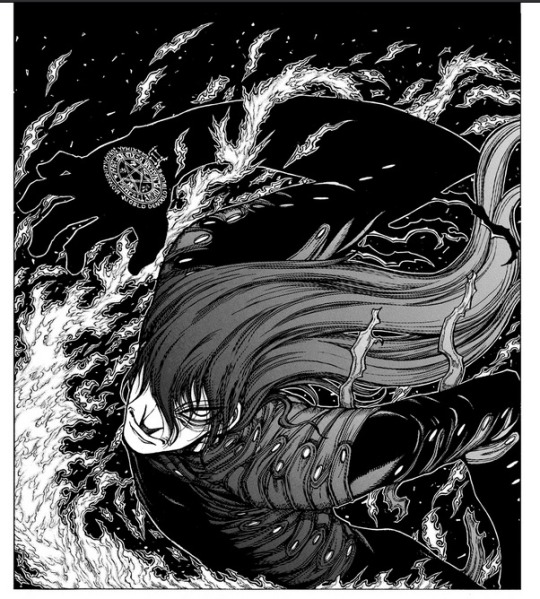
Then Al turns into this form, which I guess is the same outfit he was wearing back in 1989, when Integra found him in the basement. Not sure if that’s supposed to mean anything, though.

Oh, and I guess there’s still a few familiars that didn’t burn up from before? This is the last time we see them though, so maybe this final attack finishes them off.

As Alucard strikes the final blow on Anderson, Integra flashes back to her father, who taught her about the vampires’ inner psyche. Arthur Hellsing suggested that vampires don’t have a whole lot to show for their immortality. They crave conflict, not for its own sake, but becuse they long for death. Not just any ol’ death, but a kind of death that they could take some solace in. We’ve already seen this in Alucard, as he seems to relish the idea of being killed by a human like Anderson, or van Helsing. If all he wanted was death, he could have let that Ottoman headsman finish the job 523 years ago. Instead, he lost everything, and he’s spent centuries with nothing to take comfort in. And that probably explains why Alucard is so happy with his service to Integra. At least she gives him a purpose, a duty, a cause to fight for.
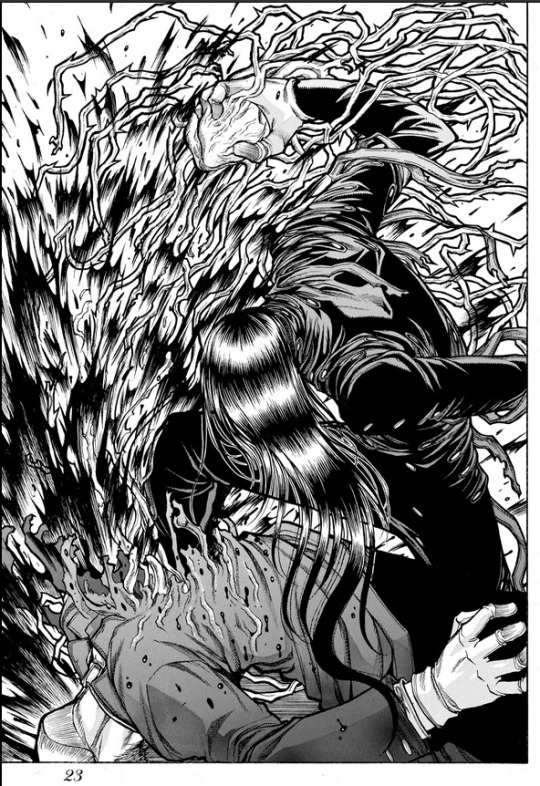
And finally, Alucard rips out Anderson’s heart, with the Holy Nail still in it.

And he crushes it, which I guess it enough to neutralize the Nail’s effect? Well, cool enough then.
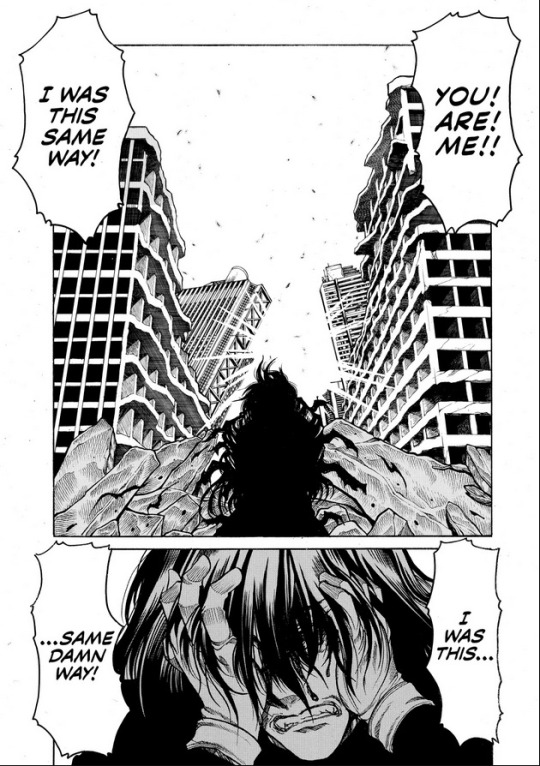
But Al takes no pleasure in this victory. He sees in Anderson a reflection of himself, back when he was a human. The fanaticism, the failure, the rejection of humanity to become a monster, and then failure again.

And then Anderson, or whats’ left of him, consoles Alucard before he dies.
#2021hellsingliveblog#hellsing#alucard#seras victoria#alexander anderson#sir integra hellsing#arthur hellsing#walter c dornez#murad ii
83 notes
·
View notes
Text
(Rexwalker + Anidala polyam they know about each other and are chill. i wrote this while ignoring a mile long list of to dos. i am made of stress and denial so i am giving these characters time to relax.)
The air inside 79s was always too hot, subpar air filters never quite keeping up with the mass of bodies confined into the small space. If it was warm enough, people would spill out onto the balcony, the low beats of the music reaching even outside.
Rex had stopped noticing the smell of spilled liquor and sweat after less than ten minutes inside. The heat, however, was starting to get to him. But maybe that was just Anakin plastered against his side.
There had been a few curious glances in their direction, natborn officers and Jetii being uncommon sights at 79s, but Anakin was with him and no one questioned them. Jesse had winked at him from the table he shared with Kix, before going back to his own drink.
Anakin’s hair was tickling his neck, and Rex looked down at where his riduur was slumped against his shoulder.
“I might have had one too many,” Anakin admitted, lifting his empty glass and giving a half shrug, somehow without dislodging himself from Rex’s shoulder. “Everything is spinning and I think I’m hearing more of people’s thoughts than I should.”
Rex knew that no Jedi, not even Anakin could read thoughts piecemeal, like a written text or an overheard conversation. But Anakin was highly sensitive to feelings, attuned to perceiving changing moods or absorbing strong images or sensations people might be projecting, and he knew Rex would understand his shorthand. When he was tired or, like in this case, drunk, filtering out the noise of the world became harder.
“Let’s get you home, then,” Rex said.
He might have hoped for a longer night, but they were coming from a long, thankless, bloody campaign, and he understood better than most the temptation of numbing it all down. Anakin had had to carry him back to the barracks a few times before, and her was more than happy to return the favour.
“Do you...” Anakin started, then mumbled something inaudible.
Rex gave him time to collect his thoughts.
“You know I love you, right?” he said after a moment, pushing himself upright to look Rex in the eye.
“Should I be worried?” Rex joked, ignoring the flutter of joy he always, always felt at those words.
Anakin pouted, and Rex couldn’t help but kiss that insufferable, beautiful pout.
“Do you, I mean, would you. Do you want to come to Padmé’s? I really miss her, but I don’t want to be without you.”
Rex hesitated. He hadn’t spent that much time with the Senator. They had a near-death experience together with the blue shadow virus, which had led to awkward confessions and a renewed mutual respect, but that was the extent. Despite sharing something incredibly important and precious, they weren’t exactly close. Rex didn’t know exactly how she felt, but he often feared overstepping, and he made a conscious effort not to monopolise Anakin’s time when they were on leave.
“Are you sure she’d be okay with this?” Rex wasn’t sure if he meant the late hour, the last minute call, or his own presence in her house.
Colour rose even more on Anakin’s cheeks. “She said... she offered. She wasn’t sure you wanted to and didn’t want to pressure you, but... And I felt so awkward! I love you both so much, but I don’t know if...” he made a vague gesture that added absolutely nothing to his babbling, but somehow, Rex understood him.
It was, in a way, like inviting Anakin to 79s. Rex loved his brothers, and he wanted Anakin to spend time with him in one of the places where he got to be himself. But there was friction. Anakin wasn’t exactly part of that world, much like Rex wasn’t part of Amidala’s. He worried for a moment about what they were going to do after the war - if they both... No, he wasn’t going to go there.
“Let’s give her a call and see if she wants to deal with your drunk ass, or I’m dropping you on Kenobi’s doorstep and washing my hands of you,” Rex said, a little more gruffly than he intended. But Anakin was smiling at him like he hung the moon and stars.
They walked - more like wobbled - outside and found a corner where they wouldn’t be overheard to make the call.
“Ani!” Padmé said with a bright smile that made her look so young. Or maybe just like herself, instead of the ageless effigy she presented to the world.
Her smile didn’t dim when she saw Rex, her eyes twinkling with mischief. “Captain. Is Anakin being a nuisance?”
“Hey, I resent that! I am a kriffing delight to be around!”
Padmé and Rex laughed at him, but fondly and without malice, and Anakin sighed, tragic and put upon.
“Once you two have finished laughing at me... Padmé, would you... can we...”
She came to his rescue. “Would you like to come over? Both of you?”
-
Padmé is waiting for them at the door - Rex notices not even her protocol droid is around, and appreciates the discretion. He’s sure there must be at least one guard somewhere on this floor, but they are alone in the apartment.
Anakin bends down to kiss Padmé. He’s tall, and he needs to angle down to kiss Rex too, but Padmé is surprisingly tiny up close. She has such a large presence, it’s easier to forget her actual height. Rex wonders idly how it feels, to be so visible and yet so invisible.
He can see her lips curl up, smiling into the kiss, her eyes blissfully close. Anakin tangles a hand into her hair, cascading freely down her back, unconstrained by headpieces or jewels, and Rex realises the level of trust she is showcasing by receiving him like this - not as Senator Amidala, but just Padmé, without her own form of armour and armour-paints.
“Come on,” she says after a moment, lips red and well-kissed, and takes them to the living room.
They all sit on a large sofa, Anakin between them looking pleased and a little nervous. Rex can relate.
Padmé offers them drinks and asks about their plans for their leave. She does not ask about the fighting, the campaign they just left behind. She does not ask about where they will be assigned next. Their conversation stays in the small confines of a few days of dirtside leave, and it’s surprisingly comforting. Rex tries to imagine them into a bubble, the galaxy outside nothing but a muted memory.
“You with us, Rex?” Anakin asks him.
He is still staring into his glass of muja juice. “Mh?”
Then he realises the other two had stopped talking and raises his eyes. “Sorry. I was just thinking... It’s nothing.”
It’s stupid, he thinks. The bubble bursts, the outside world filters back in. It’s all well and good to enjoy leave, but this it all this is: a moment respite, a parenthesis in a history of war. Rex knows no other life and maybe he never will.
Anakin takes his hand and just holds it, waiting in silence. Padmé peers over at him, frowning. “Would you like to talk,” she asks, “Or to be left alone? Or do you want to talk just with Anakin?”
She disentangles herself from Anakin and is about to stand up, when Rex stops her. “No, no. I’m not about to... this is your house. I’m not going to kick you out from your own living room. Maybe I should go.”
Anakin’s fingers tighten around his, but before he can say a word, Padmé is standing in front of him. “Rex. I like to think we will be friends, one day, but I can’t presume to know you yet, and I have no right to your every thought. Please. Let me give you some space.”
There is vice around Rex’s throat and he can only nod. He watches her go, her ridiculously long, impractical blue robe trailing after her, and he almost calls her back. He wants her to know how he feels.
But he isn’t sure she would understand, and he isn’t ready to risk it yet. So he spills his heart to Anakin, who is ready to receive it all. Anakin always promises him they will both see the end of the war, and sometimes Rex gets angry at him for that. Anakin isn’t babying him, he truly believes that, but Rex can’t always accept the weight of that hope. Tonight, though, he leans with his forehead against Anakin’s chest, and lets him caress his head, his back, and talk promises of peace.
“I will keep you safe. I will keep you all safe,” Anakin promises, bright and impossible, and Rex believes him.
Padmé comes back after a while with hot chocolate and cookies. They eat and drink and Padmé gets a cream moustache and does a frighteningly accurate imitation of Admiral Yularen that makes Anakin laugh until there are tears in his eyes. Rex, who is maybe still a little bit tipsy, does Obi-Wan. Padmé is gasping for air and accusing him of having a recording of Master Kenobi hidden somewhere.
“I’ve just been present for many of General Kenobi’s lectures. Somehow,” he side eyes Anakin, “Someone always ends up prompting them.”
“I am a victim!” Anakin says, and keep laughing.
It gets late enough that the conversation slows down and they are all yawning more than they are talking, and Rex thinks it’s time to go.
“You should stay, Rex. Stay for breakfast. Mon brought me a giant box of chandrillan spiced chocolate pastries that I will never be able to finish on my own. Unless of course you’ll be needed too early tomorrow?”
Rex can see through the flimsi thin excuse, and he appreciates the easy way out. Which he should take. He should go and leave Anakin alone with his wife. He should go back to the barracks in case he was needed. Should, should, should.
“I would love to,” his traitorous voice says, lower and more uncertain than he has ever sounded. “Stay, I mean.”
“I’ll go find some spare sleeping clothes,” Anakin offers helpfully, then winks - winks! the shameless flirt - at him, “I’m sure you won’t mind.”
Padmé looks between them, the faintest pink colouring her cheeks. “I’ll show you to the guest room,” she says, standing up and beckoning him to follow.
The guestroom is, as expected, far bigger than necessary and with its own attached fresher.
When Anakin fails to come back, Padmé goes in search of him. Rex hears a faint laughter, and Padmé reappears with some folded clothes. “He passed out face down on the bed.”
She hands him the clothes and her small, soft hand touches his. He smiles at her and wishes her goodnight.
And it is. For tonight, still, they are at peace.
#gondolin writes#fic#rexwalker#anidala#polyamory#anakin skywalker#padme amidala#captain rex#my tag#maybe i'll re read this#some day#i think i fucked up tenses#rex pov#tcw#rarepair#my fic
114 notes
·
View notes
Text
Obey Me! Devilgram Posts and Comments: A Party for You (Prelude)/A Party for You (Septet)
Oh hey it’s a translation post! Not like this was for the 6-month anniversary and we’re nearing a year now, noooo...
This one was REALLY easy, which unfortunately means it also isn’t a very interesting one ;w;
I guess it helps me to catch up at least, but so many of them were near-exact that it almost feels like it wasn’t necessary. Hopefully the next one will be more fun.
I guess, just in case it needs to be said since there was the minor TOS scare a little bit ago: Everything I’m translating in these posts is accessible to anyone as long as their language is set to Japanese. You don’t need to own the card to see these comments, so nothing about this gives away information that was not already readily available to all.
Anyway, the full transcript is below the cut as usual.
日本語は私の第三言語ので、時々間違えます。日本語話者、間違いを見たら教えてください。 (Japanese is my third language, so I make mistakes sometimes. Japanese speakers, if you see a mistake, please tell me!)

Let’s Go on a Date!
Belphie: Oh, you’re going together?
Satan: Maybe I should go too
Lucifer: Care to explain what you’re doing?(1)
Simeon: Looks like fun!
#Date #Monopolizing

A Party Night Miracle?(2)
Diavolo: It’s ok to invite me too, you know?
Mammon: The thing next to him is mine!
Barbatos: You should absolutely avoid overdrinking(3)
Simeon: A miracle that will go down in history
#Party #Demonus

A Photo of Just(4) Me and You
Simeon: I want to join in
Asmo: Huh? You two snuck off together?
Luke: That’s no fair!
Satan: A cat phone wallpaper would be good too
#TwoShot #Wallpaper

Dance Showdown!
Lucifer: It’s certainly professional
Solomon: Not bad
Beel: Belphie’s so cool
Luke: I’m going to dance too
#Party #Dance

You, Through the Viewfinder(5)
Solomon: The camera’s structure itself is really interesting too
Lucifer: Looks like they’re doing it well
Barbatos: Feel free to take a photograph of the Young Master as well
Luke: Give me one too
#Model #Photo

Queen of Jealousy
Diavolo: I wonder what it’s used for?
Belphie: No eating
Mammon: Something like him getting angry is rare
Asmo: That sort of Beel is really nice too
#Jealousy #Flowers

Piano Timbre for You
Simeon: Music is great in any realm, isn’t it?
Levi: Every single anime song is a masterpiece too(5)
Belphie: It’s a story from a few centuries ago
Satan: What a nostalgic sound
#Piano #Lullaby
1. のです (in this case んだ) suggests an explanation, and while usually implied it kind of wasn’t here, so I tried to fit that in.
2. Lmao why is it a question?
3. Literally it’s “Overdrinking is something that should be carefully avoided” but like, that doesn’t sound natural at all.
4. The word “just” isn’t there, but ツーショット (two shot) is a picture specifically of two people, but in English two shot is a camera angle used in cinema, so. That’s where it comes from in the official translation too.
5. アニソン (anison) is the shorthand way to say anime song!
Masterpost
デートに行こうぜ!
ベルフェ:へー、2人で行くんだ
サタン:俺も行こうかな
ルシファー:お前たちは何をやっているんだ
シメオン:楽しそうだね!
#デート #独り占め
パーティーの夜の奇跡?
ディアボロ:私も呼んでくれていいんだよ?
マモン:あいつの隣は俺の物だ!
バルバトス:飲みすぎは禁物ですよ
シメオン:歴史に残る奇跡だね
#パーティー #デモナス
ぼくと君のツーショット
シメオン:俺も混ざりたいな
アスモ:あれ?2人で抜け出したの?
ルーク:それずるいぞ!
サタン:猫の待ち受けもいいぞ
#ツーショット #待ち受け
ダンス対決!
ルシファー:確かにプロだな
ソロモン:やるじゃないか
ベール:ベルフェカッコイイ
ルーク:僕とも踊るぞ
#パーティー #ダンス
ファインダー越しの君
ソロモン:カメラは構造自体も興味深い
ルシファー:上手くやっているようだな
バルバトス:坊ちゃまの写真もぜひ
ルーク:ぼくにも1枚くれ
#モデル #写真
嫉妬の女王
ディアボロ:何に使うのかな?
ベルフェ:食べるなよ
マモン:あいつが怒るなんて珍しい
アスモ:あんなベールもなかなかいいね
#嫉妬 #花
ピアノの音色を君に
シメオン:どの世界でも音楽っていいよね
レヴィ:アニソンだって名曲揃いだ
ベルフェ:何百年前の話だよ
サタン:懐かしい音だ
ピアノ #子守歌
ただいま……
ところで、「ファインダー越し」を読んだ時、A3!の臣さんのキャラソンのせいであの漢字をちゃんと推測できたwww
#obey me#obey me one master to rule them all#obey me shall we date#obey me swd#shall we date obey me#swd obey me#obey me!#obey me translation#devilgram#obey me lucifer#obey me mammon#obey me leviathan#obey me satan#obey me asmodeus#obey me beelzebub#obey me belphegor#obey me diavolo#obey me barbatos#obey me simeon#obey me luke#obey me solomon
30 notes
·
View notes
Video
youtube
Story at-a-glance
Behind the scenes of many of the companies that provide the products and services you use each day are two investment firms that own more shares than other shareholders. The list includes social media, transportation, news media, food manufacturers and pharmaceutical companies
Blackrock and Vanguard hold large interests in pivotal companies, and Vanguard holds a large share of Blackrock. In turn, Blackrock has been called the "Fourth Branch of Government" by Bloomberg as they are the only private firm that has financial agreements to lend money to the central banking system
Blackrock also developed the software used by the Fed to manage financial transactions; one Princeton University lecturer has said Blackrock controls the Federal Reserve and has more power than most governments
Ascertaining who owns large portions of Vanguard is more difficult as it is a private company that is not publicly traded. It's important to think globally but act locally to protect your civil rights, including supporting state legislators who support your right to choose health care
Until recently, it has appeared that economic competition has been driving the rise and fall of small and large companies across the U.S. Supposedly, PepsiCo is Coca Cola's competitor, Apple and android are vying for your loyalty and Pfizer and Bayer are battling for your pharmaceutical dollars. But what is revealed in this video, using publicly available data you can check, is that this has been an illusion.
On the surface, all appears to be the same as it always has been. But the growth of a few corporations, beginning in the mid-1970s, has all but destroyed the competitive market on which America's strength has rested. As demonstrated in the video, a quick look through Yahoo! Finance shows that Vanguard and Blackrock have been the puppet masters behind nearly every large industry that affects your life.
As you can quickly discern, the global economy may be the greatest illusionary trick ever pulled over the eyes of people around the world. Without doubt, we are in a new place and facing new challenges. It will take accurate information and local action to continue to have the right to take control of your health.
Behind the Scenes, Two Companies Own the Supply Chain
As you watch the video, you'll see that most of the large corporations that supply the food, information, data and drugs used every day are controlled by a select few investment firms whose sole goal is a greater return on their profits. Of course, that's been the backbone of a competitive economy — to grow your profit margin while competing against other companies for the same market.
In theory, this competition drives innovation, advancement and price structures that benefit the consumer. However, when one, two or three large companies own most of what you use, competition becomes an illusion, resulting in a monopoly where companies can set a price and there are no other products from which to choose.
As the World Economic Forum1 and United Nations2 collaborate to "build back better," it is crucial to pay attention to how large corporations across the world may contribute to a societal shift that moves more money into the hands of billionaires and creates a new depth of poverty across the world.
One of the mandates for the Federal Trade Commission is to ensure there is competition in the marketplace. For example, in 2000, a federal judge ruled that Microsoft had maintained a monopoly with Windows and tied the company browser, Internet Explorer, to the operating system, thus gaining a greater economic foothold.3
The company barely escaped being split up, until it agreed with a settlement to curb its practices. More than 20 years later, the Department of Justice is now looking at antitrust allegations against Google's business dealings that have hurt smaller competitors.4 But the two major investors in both these companies appear to have escaped unscathed.
As you go through the list of companies in which Vanguard and Blackrock strategically hold a large investment interest, consider how the products and services provided by these companies are inextricably intertwined with your daily life.
Google
YouTube
Facebook
Twitter
Instagram
Amazon
Alibaba
Pfizer
Bayer Pharmaceuticals
AstraZeneca
PepsiCo
Coca Cola
Microsoft
Apple
Netflix
Reuters
Viacom (CBS)
ATT
Tesla
The New York Times
Agricultural Bank of China
FedEx
American Airlines
United Airlines
TUI AG
Zimmer Biomet Holdings
Volkswagen AG
Ford Motor Company
You may recognize many of these names and some may not be as recognizable. You can do your own search on Yahoo! Finance,5 typing in the company and clicking "holdings" in the navigation bar. The companies span a variety of aspects of daily life, including:
Social media
Shopping
Food manufacturers
Technology and software
Pharmaceutical companies
Entertainment
Communications
Airlines
Medical equipment
Transportation
Holiday companies
Car companies
World media
However, as comments on my Twitter feed indicate, it is not always apparent why this information is important to your rights as an individual.6 It may be difficult to imagine a world where your news is being manipulated. As is illuminated in the video, Vanguard and Blackrock:7
"... own the news that's been created, they own the distribution of the news that's been created, they own the lives of the reporters that are reporting the news that's being distributed that's being created on your TV screen. CBS, FOX, ABC, it doesn't matter which you're watching.
They all are using that wonderful phrase from Davos now — build back better. The point being is that you've got very few people controlling everything and that's information. Talk about information is power, well not only do they create the information, but they have all the distribution nodes to literally change the world mindset as it were."
Every Media Chain Using the Same Narrative
Davos is a ski town in the Swiss Alps but has become the shorthand for the World Economic Forum Annual Meeting that's held in the town.8 It is a chance for some of the most powerful figures in the world to collaborate. The meeting has been headed and organized by Klaus Schwab, an 83-year-old German engineer and economist. As you consider what you're hearing in the news, remember:9
"Everything we see on the shelves in the shops, what you buy online, who delivers it, who is making the COVID jab, who is distributing the jab, who is reporting on the jab, who is censoring alternative information about the jab, and all the rest of it. It's all the same people."
The consistency of news reporting across mainstream media should now make sense since each of them have similar major investors and those major investors have a singular focus of raising their profit margin while pushing the Fourth Industrial Revolution. How can you believe what's being told in the news when every news channel is saying the same thing?
It may have been that Bob Woodward and Carl Bernstein, who broke the Nixon Watergate story in 1972, were the last investigative journalists working for a major news media company who were allowed to follow a news story to conclusion without blatant censorship.
Around the world, doctors are being silenced. At the beginning of the pandemic, medical professionals were told not to speak to the media about a lack of personal protective equipment within the hospital. Although the American Medical Association10 initially came out in support of a physician's right to speak out about the care conditions, the tables have since turned.
In the quick, six-minute video below, Dr. Dan Stock from McCordsville, Indiana, a suburb of Indianapolis, speaks to the board of the Mount Vernon Community School Corporation. He provides the board with documentation to back up his claim that the way in which the community was addressing an attempt to stop the spread of infection was, in fact, ineffective.
The video went viral11 with several million views within a day of its posting on YouTube, before it was taken down for “violating YouTube’s community guidelines.” August 11, 2011, Tucker Carlson featured the video and Stock on his Fox show,12 where Stock said, “It seems to me that focusing on immune system improvement whether through a vaccine or non-vaccine methods is the more rational approach to this.”
Yet, even though Stock provides research evidence and speaks knowledgeably about the transmission of viral illnesses, the rest of mainstream media have not picked up on the story and this information is not being communicated to the public. Those in power want to ensure this type of information is not shared because it's contrary to the narrative they are promoting.
House for Sale? Blackrock Is Interested
A recent expose in The Wall Street Journal warns, "… yield-chasing investors are snapping up single-family houses to rent out or flip. They are competing for houses with ordinary Americans, who are armed with the cheapest mortgage financing ever, and driving up home prices."13
Yet, why would institutional investors be interested in overpaying for single family homes? To gain a greater understanding of the answer, you must take a look at Blackrock's partners, which include the World Economic Forum. The company manages assets that are worth $5.7 trillion and appears to be focused on pushing the average American out of the housing market.
If most of the available housing is owned by investment groups and corporations, they become your landlord. This is one of the ways in which the World Economic Forum envisions society in 2030. It's the part where you will "own nothing and be happy."
While it sounds like it came straight from George Orwell's book, "1984," it is in fact the agenda published on the World Economic Forum website.14 In fact, Forbes15 published an article in 2016 titled "Welcome To 2030: I Own Nothing, Have No Privacy And Life Has Never Been Better," which was written by the World Economic Forum.
Interestingly, the World Economic Forum once had a link to the article on their website under "agenda," but that link is now dead,16 even though a WEF Twitter post17 touting it in 2017 is still up. The link on the Twitter post, however, is also dead. And, curiously, in February 2021, Reuters did a "fact check" which claims the WEF never had anything to do with it.
The Fourth Branch of Government
BlackRock not only is an investment firm, but also has been called the "Fourth Branch of Government" because they are the only private firm with an intimate relationship with the Federal Reserve and financial agreements to lend money to the central banking systems. Interestingly, software developed by BlackRock — Aladdin — is used by the Fed to manage their financial transactions.18
In comparison to other large financial investment firms who have political ties to one party or the other, Blackrock "possesses a power that's more technocratic."19 The firm has a global influence as well. They were tapped as an adviser to the Bank of Canada and the European Union hired them to advise them on incorporating governing and social practices.
According to an analysis by Bloomberg,20 the company may be paid as much as $48 million a year in fees, which could cement the company's ties with powerful policymakers.
To put this into perspective, BlackRock, an investment firm, has more power than most governments and controls the Federal Reserve, Wall Street mega-banks like Goldman Sachs and the WEF's Great Reset, according to F. William Engdahl, a strategic risk consultant and lecturer who holds a degree in politics from Princeton University.21 They don't just want your house, they want your life.
But Who Owns Vanguard?
When you take a look at who owns the largest portion of BlackRock, you learn its Vanguard.22 But ascertaining who has the greatest investment in Vanguard is a little more difficult. The company has a corporate structure that makes ownership challenging to discern.
It appears it's owned by a variety of funds, which in turn are owned by shareholders. Aside from these shareholders, the company has no outside investors and is not publicly traded. As reported in the featured video:23
"The elite who own Vanguard apparently do not like being in the spotlight, but of course they cannot hide from who is willing to dig. Reports from Oxfam and Bloomberg say that 1% of the world, together owns more money than the other 99%. Even worse, Oxfam says that 82% of all earned money in 2017 went to this 1%.
In other words, these two investment companies, Vanguard and BlackRock, hold a monopoly in all industries in the world and they, in turn, are owned by the richest families in the world, some of whom are royalty and who have been very rich since before the Industrial Revolution."
Although getting to the bottom of the major investors in Vanguard is difficult, it's important to keep in mind that BlackRock and Vanguard, individually and combined, own enough shares in Big Pharma and mainstream media to have control over what is produced, shared and distributed.
This information is important because it is the drug companies and media that are driving the response to this infection. Thus far, it has all endangered rather than optimized public health and the official narrative continues to be false, leading the public further astray and fostering fear based on lies.
To have a chance of righting this situation, we must understand the central players and why these false narratives are being created in the first place. In the Global Justice Now December 2020 report entitled "The Horrible History of Big Pharma,"24 they review the shameful history of the top seven drug companies in the world.
These companies are now developing and manufacturing drugs and gene-based "vaccines" against COVID-19, while mainstream media have helped suppress information about readily available older drugs that have been shown to have a high degree of efficacy against the infection.
Think Globally and Act Locally
Just as the market collectively impacted the downfall of the Grocery Manufacturers Association,25 you have an impact in your local community. It may be overwhelming to consider how quickly the world is changing, but you can have a voice in your local community.
As you may know, after my articles have been published for 48 hours, they are no longer available to read. This means, to reference the information you need to protect your health, you must copy and paste the articles and keep them on your hard drive. I encourage you to share these with your friends and family and encourage them to share as well.
It may be inconceivable to think about making a difference on a national scale to protect your civil rights, but there are approaches you can take on a local level that will make a big difference as people across the world speak up.
Many large communities and states are forming groups to stand up for individual rights, to prevent vaccine passports and limit governmental power in a peaceful manner.26 It's also important to find a group with which to work and to support your state legislators who support your right as an individual to choose your health care.
4 notes
·
View notes
Photo

Today we present a preview of a major new biography of Sylvia Plath, Red Comet, coming this fall. Through committed investigative scholarship, Heather Clark is able to offer the most extensively researched and nuanced view yet of a poet whose influence grows with each new generation of readers. Clark is the first biographer to draw upon all of Plath's surviving letters, including fourteen newly discovered letters Plath sent to her psychiatrist in 1961-63, and to draw extensively on her unpublished diaries, calendars, and poetry manuscripts. She is also the first to have had full, unfettered access to Ted Hughes's unpublished diaries and poetry manuscripts, allowing her to present a balanced and humane view of this remarkable creative marriage (and its unravelling) from both sides. She is able to present significant new findings about Plath's whereabouts and her state of health on the weekend leading up to her death. With these and many other "firsts," Clark's approach to Plath is to chart the course of this brilliant poet's development, highlighting her literary and intellectual growth rather than her undoing. Here, we offer a passage from Clark's prologue to the biography, followed by lines from one of Plath's celebrated "bee poems."
from Red Comet: The Short Life and Blazing Art of Sylvia Plath
The Oxford professor Hermione Lee, Virginia Woolf’s biographer, has written, “Women writers whose lives involved abuse, mental-illness, self-harm, suicide, have often been treated, biographically, as victims or psychological case-histories first and as professional writers second.” This is especially true of Sylvia Plath, who has become cultural shorthand for female hysteria. When we see a female character reading The Bell Jar in a movie, we know she will make trouble. As the critic Maggie Nelson reminds us, “to be called the Sylvia Plath of anything is a bad thing.” Nelson reminds us, too, that a woman who explores depression in her art isn’t perceived as “a shamanistic voyager to the dark side, but a ‘madwoman in the attic,’ an abject spectacle.” Perhaps this is why Woody Allen teased Diane Keaton for reading Plath’s seminal collection Ariel in Annie Hall. Or why, in the 1980s, a prominent reviewer cracked his favorite Plath joke as he reviewed Plath’s Pulitzer Prize–winning Collected Poems: “ ‘Why did SP cross the road?’ ‘To be struck by an oncoming vehicle.’ ” Male writers who kill themselves are rarely subject to such black humor: there are no dinner-party jokes about David Foster Wallace.
Since her suicide in 1963, Sylvia Plath has become a paradoxical symbol of female power and helplessness whose life has been subsumed by her afterlife. Caught in the limbo between icon and cliché, she has been mythologized and pathologized in movies, television, and biographies as a high priestess of poetry, obsessed with death. These distortions gained momentum in the 1960s when Ariel was published. Most reviewers didn’t know what to make of the burning, pulsating metaphors in poems like “Lady Lazarus” or the chilly imagery of “Edge.” Time called the book a “jet of flame from a literary dragon who in the last months of her life breathed a burning river of bale across the literary landscape.” The Washington Post dubbed Plath a “snake lady of misery” in an article entitled “The Cult of Plath.” Robert Lowell, in his introduction to Ariel, characterized Plath as Medea, hurtling toward her own destruction.
Recent scholarship has deepened our understanding of Plath as a master of performance and irony. Yet the critical work done on Plath has not sufficiently altered her popular, clichéd image as the Marilyn Monroe of the literati. Melodramatic portraits of Plath as a crazed poetic priestess are still with us. Her most recent biographer called her “a sorceress who had the power to attract men with a flash of her intense eyes, a tortured soul whose only destiny was death by her own hand.” He wrote that she “aspired to transform herself into a psychotic deity.” These caricatures have calcified over time into the popular, reductive version of Sylvia Plath we all know: the suicidal writer of The Bell Jar whose cultish devotees are black-clad young women. (“Sylvia Plath: The Muse of Teen Angst,” reads the title of a 2003 article in Psychology Today.) Plath thought herself a different kind of “sorceress”: “I am a damn good high priestess of the intellect,” she wrote her friend Mel Woody in July 1954.
Elizabeth Hardwick once wrote of Sylvia Plath, “when the curtain goes down, it is her own dead body there on the stage, sacrificed to her own plot.” Yet to suggest that Plath’s suicide was some sort of grand finale only perpetuates the Plath myth that simplifies our understanding of her work and her life. Sylvia Plath was one of the most highly educated women of her generation, an academic superstar and perennial prizewinner. Even after a suicide attempt and several months at McLean Hospital, she still managed to graduate from Smith College summa cum laude. She was accepted to graduate programs in English at Columbia, Oxford, and Radcliffe and won a Fulbright Fellowship to Cambridge, where she graduated with high honors. She was so brilliant that Smith asked her to return to teach in their English department without a PhD. Her mastery of English literature’s past and present intimidated her students and even her fellow poets. In Robert Lowell’s 1959 creative writing seminar, Plath’s peers remembered how easily she picked up on obscure literary allusions. “ ‘It reminds me of Empson,’ Sylvia would say . . . ‘It reminds me of Herbert.’ ‘Perhaps the early Marianne Moore?’ ” Later, Plath made small talk with T. S. Eliot and Stephen Spender at London cocktail parties, where she was the model of wit and decorum.
Very few friends realized that she struggled with depression, which revealed itself episodically. In college, she aced her exams, drank in moderation, dressed sharply, and dated men from Yale and Amherst. She struck most as the proverbial golden girl. But when severe depression struck, she saw no way out. In 1953, a depressive episode led to botched electroshock therapy sessions at a notorious asylum. Plath told her friend Ellie Friedman that she had been led to the shock room and “electrocuted.” “She told me that it was like being murdered, it was the most horrific thing in the world for her. She said, ‘If this should ever happen to me again, I will kill myself.’ ” Plath attempted suicide rather than endure further tortures.
In 1963, the stressors were different. A looming divorce, single motherhood, loneliness, illness, and a brutally cold winter fueled the final depression that would take her life. Plath had been a victim of psychiatric mismanagement and negligence at age twenty, and she was terrified of depression’s “cures,” as she wrote in her last letter to her psychiatrist—shock treatment, insulin injections, institutionalization, “a mental hospital, lobotomies.” It is no accident that Plath killed herself on the day she was supposed to enter a British psychiatric ward.
Sylvia Plath did not think of herself as a depressive. She considered herself strong, passionate, intelligent, determined, and brave, like a character in a D. H. Lawrence novel. She was tough-minded and filled her journal with exhortations to work harder—evidence, others have said, of her pathological, neurotic perfectionism. Another interpretation is that she was—like many male writers—simply ambitious, eager to make her mark on the world. She knew that depression was her greatest adversary, the one thing that could hold her back. She distrusted psychiatry—especially male psychiatrists—and tried to understand her own depression intellectually through the work of Fyodor Dostoevsky, Sigmund Freud, Carl Jung, Virginia Woolf, Thomas Mann, Erich Fromm, and others. Self-medication, for Plath, meant analyzing the idea of a schizoid self in her honors thesis on The Brothers Karamazov.
Bitter experience taught her how to accommodate depression—exploit it, even—in her art. “There is an increasing market for mental-hospital stuff. I am a fool if I don’t relive, or recreate it,” she wrote in her journal. The remark sounds trite, but her writing on depression was profound. Her own immigrant family background and experience at McLean gave her insight into the lives of the outcast. Plath would fill her late work, sometimes controversially, with the disenfranchised—women, the mentally ill, refugees, political dissidents, Jews, prisoners, divorcées, mothers. As she matured, she became more determined to speak out on their behalf. In The Bell Jar, one of the greatest protest novels of the twentieth century, she probed the link between insanity and repression. Like Allen Ginsberg’s Howl, the novel exposed a repressive Cold War America that could drive even the “best minds” of a generation crazy. Are you really sick, Plath asks, or has your society made you so? She never romanticized depression and death; she did not swoon into darkness. Rather, she delineated the cold, blank atmospherics of depression, without flinching. Plath’s ability to resurface after her depressive episodes gave her courage to explore, as Ted Hughes put it, “psychological depth, very lucidly focused and lit.” The themes of rebirth and renewal are as central to her poems as depression, rage, and destruction.
“What happens to a dream deferred?” Langston Hughes asked in his poem “Harlem.” Did it “crust and sugar over—/ like a syrupy sweet?” For most women of Plath’s generation, it did. But Plath was determined to follow her literary vocation. She dreaded the condescending label of “lady poet,” and she had no intention of remaining unmarried and childless like Marianne Moore and Elizabeth Bishop. She wanted to be a wife, mother, and poet—a “triple-threat woman,” as she put it to a friend. These spheres hardly ever overlapped in the sexist era in which she was trapped, but for a time, she achieved all three goals.
They thought death was worth it, but I
Have a self to recover, a queen.
Is she dead, is she sleeping?
Where has she been,
With her lion-red body, her wings of glass?
Now she is flying More terrible than she ever was, red
Scar in the sky, red comet
Over the engine that killed her—
The mausoleum, the wax house.
from “Stings” by Sylvia Plath
More on this book and author:
Learn more about Red Comet: The Short Life and Blazing Art of Sylvia Plath by Heather Clark
Learn more about Heather Clark
Share this poem and peruse other poems, audio recordings, and broadsides in the Knopf poem-a-day series
To share the poem-a-day experience with friends, pass along this link
146 notes
·
View notes
Note
Any domestic/slice of life headcanons about Xehanort and Eraqus in your lost masters au? I am VERY MUCH in love with the dynamic you gave them
When they first move to Destiny Islands they stay with Xehanort's older sister. Didn't know Xehanort had an older sister? Neither did Eraqus until they were on her doorstep. The most surprising thing is not that Xehanort didn't tell him, though it does hurt, but that she doesn't seem to have near as many questions as she should and just welcomes them both in like Xeha has been gone for an afternoon instead of several years and she already knows Eraqus. In the same vein, there's a cry from the other room, and Xehanort shows no surprise and says he'll get the baby since he probably woke them up. The whole family is just Like That. Questions trickle out over time and get answered by a mixture of creative lies and the truth.
When deciding what to do longterm now that they've successfully escaped their lives as keyblade wielders, making island crafts to support themselves is Eraqus's first plan. Xehanort lovingly points this out as impractical, and by lovingly I mean with a condescending, yet affectionate laugh and some barbs about Eraqus's artistic talents to go along with the realities of how that's not a sustainable primary source of income when you are just starting out.
Eraqus isn't the only dreamer though. Xehanort has aspirations of building them a house. Eraqus has faith in him to follow through, and does think the idea of living in a beach shack sounds romantic, but also points out that there's a lot of perfectly nice places to stay in town and Xehanort was right when he pointed out they need to look at ways to support themselves first. Xehanort's sister who I need to name doesn't mind them staying with her as long as they need especially when they are both useful around the house and free babysitting.
Though the handicraft thing does work out as Eraqus's "retirement job" his first job is working at a hotel on the main island and eventually moving up to managing it as time goes on.
Xehanort finds work fishing/supplying a restaurant near the hotel Era works at.
Though they are already #married when they come to the islands, and they have an exchange of vows that first day on the shore, a mixture of some really solemn exchange of words from some dusty book of keybearer traditions (because you know they had a ceremony for everything) and some extemporaneous speech from Eraqus to try and match the speech Xehanort gave to convince him to run away, they have a Destiny Islands ceremony a few years in. It's small and casual and more because other people need it.
Even though they are only barely adults themselves when they come to the island, they collect kids more quickly than they collect sand tracked into the house from the very first moment. At first these are hangers-on that just want to know the story of the new elements (no, not the world traveling, what really happened) or find out why they are so interesting to everyone else, and treated like annoying younger siblings, but, once they are older and they still end up with ducklings following them more often than not, they do become surrogate parents for any small thing that comes within radius. But part of what makes them great with kids is that they only have to deal with them in small doses.
Riku is actually related to Xehanort by blood. They weren't just randomly claiming him in that excerpt I posted before. He's Xehanort's great nephew, son of his sister's kid. Calling him the grandson was just easier shorthand with a stranger.
Eraqus goes gray sooner/more fully than in canon, and Xehanort takes a lot longer to lose his hair, though he does still go egg bald. Eraqus keeps his hair shorter than in canon because the islands are hot. Xehanort when he had hair, generally wore it up off his neck.
When Xehanort started to go bald, Eraqus started insisting he wear hats. He also insisted on adding a bunch of flair to these hats all kinds of feathers and shells and good luck charms stuck to fish hooks and then hooked into the brims. The island kids helped.
23 notes
·
View notes
Text
The album anticipates questions surrounding the singer’s genre bona fides and leans into each contradiction.
By Jonathan Keefe
4,5 STARTS
ountry and roots music are too often used as shorthand for “serious” artistry, a notion steeped in matters of race and rockist authenticity fetishes. The implication that pop music is an inherently lesser art form has been the focus of the discourse around albums by Justin Timberlake, Lady Gaga, and Miley Cyrus in recent years. Taylor Swift’s Folklore has already been subject to similar—and perhaps similarly misguided—scrutiny. That Swift has enlisted Aaron Dessner of the highly regarded indie-rock band the National as both a songwriting and producing partner—in addition to her frequent pop collaborator Jack Antonoff—and has embraced a grayscale, rustic visual aesthetic for the project has led many to declare the album a credibility maneuver or act of rebranding.
What makes Folklore such a compelling album, then, are the countless ways in which Swift, the savviest and most acutely self-conscious artist of her generation, anticipates questions surrounding her genre bona fides and leans into each apparent contradiction. She invites this degree of “What does it mean?” discursive handwringing because, on some level, it frees her to make the music she wants to make at any given moment. Folklore is neither a culmination of Swift’s career to date nor a pivot in a new direction. She’s doing exactly what she’s always done: offering a collection of incisive, often provocative songs that incorporate authentic, first-person details and leaving others to argue over specific genre signifiers.
Song for song, Folklore finds Swift at a new peak in her command of language. While tracks like “Cardigan” and “Invisible Strings” hinge on protracted metaphors, “Mad Woman” and “Peace” are blunt and plainspoken. In every instance, what’s noteworthy is Swift’s precision in communicating her exact intent. “I can change everything about me to fit in,” she sighs on “Mirrorball,” a sentiment that’s emblematic of her ability to bait autobiographical readings while also actively subverting them. If she’s offering a comment on her own desire to keep up with next-gen pop stars like Billie Eilish, then the obvious follow-up question is why nothing on Folklore sounds like a viable Top 40 single. Swift’s answer comes in the song’s final stanza, a marvel of vulnerability: “I’m still trying everything/To keep you looking at me.”
In other words, Swift’s at a point in her career where she knows chart success is incidental to broad cultural impact, and she has the cachet to sacrifice the former for the sake of the latter. “All Too Well,” from 2012’s Red, has rightfully become one of her signature songs despite not ever having been released as a single, and that same fate seems likely for many of the tracks here. Every song on Folklore boasts at least one couplet or stanza that’s simply extraordinary for its command of language, narrative voice, empathy, or some combination thereof.
The standout “Seven” first presents itself as a wistful remembrance of childhood before revealing the complexities of what we lose as we age: “Picture me in the weeds/Before I learned civility/I used to scream ferociously/Whenever I wanted.” The song also presents a queer text within Swift’s songwriting for the first time, which broadens the narrative voices she’s employed over the course of her career. “Illicit Affairs” builds to what seems like it will be one of the singer’s trademark middle-eight tone shifts, only to end abruptly without resolving into another chorus, enhancing the sense of finality in her dressing-down of a former lover. Rather than pulling her punches by repeating a catchy refrain or hook, she lets some of her bitterest lines linger, and it’s one of the album’s most impactful moments. Later, she sings from the POV of the rejected party on “This Is Me Trying” to devastating effect: “You told me all of my cages were mental/So I got wasted like all my potential.” The track finds Swift giving credence to the other person’s view of her, making for an even more believable narrator.
Swift’s early albums were hamstrung by her insistence that hers was the only story to be told—that, essentially, she was the protagonist in everyone else’s autobiography, and not just in her own. Folklore’s shifting perspectives—an homage to heiress Rebekah Harkness on “The Last Great American Dynasty,” the queer through line in the love triangle of “Cardigan,” “August,” and “Betty”—highlight how Swift’s widening worldview has deepened her skills as a songwriter. And even if none of these tracks sound like a “hit,” “Invisible String” and “This Is Me Trying” still demonstrate Swift’s masterful grasp of song structure. Her use of repetition throughout the album is particularly effective: “The 1” invokes both “the greatest films of all time” and “the greatest loves of all time” as sources of regret, while each stanza on “Invisible String” begins with a line that uses passive voice to create a narrative remove.
That Swift employs her long-established songwriting tropes in novel ways is truly the most significant development on Folklore, rather than her choices of collaborators or whether the album scans as pop or alternative or electro-folk. She’s mined this type of melancholy tone before, but never for the full length of an album and certainly never with such a range of perspectives. It isn’t the weight of the subject matter alone that makes the album feel so vital—it’s the exemplary caliber of her writing. She may sing of wasted potential, but Folklore finds Swift living up to all of the praise she earned for her songwriting earlier in career.
21 notes
·
View notes
Text
This may be a bit random, but I’ve been trying to figure out if I want to cement my own takes on nicknames for the common slate of AU skelebros (UT-UF-US-SF-HT).
On the one hand, using the defaults (eg, Blue and Black for US and SF Sans) is a shorthand that’s usually quickly understood. And it’s been long enough that it’s a pretty automatic association for me too, heh.
On the other... I do like the idea of being able to better differentiate my takes on the guys, especially with the Swap verses, as they’ve got some of the widest variation in depictions. Additionally, I like working with the HT guys, but my take on them is varied enough too, and I don’t quite like violent names being the ones that stuck in the long run - rather, that they’d change the unfortunate ones in the end. Especially bc I’m fond of the take that they came from yes, a violent/human eating sort of background, but they’re not... intending on murdering or anything now that they’re no longer in famine, even if they’re not as cuddly/sheltered from the necessity of violence to survive like their classic selves.
Hmmm...
Alright, I’ll put my thoughts on what I might stick to below a cut, for anyone who’s interested! Let me know too if you like the idea of different nicknames, or if you’d strongly prefer I stick with fandom-standard? It’d make a big difference!
Sidenote before I jump into it! One primary reason for my current musing on this is that they’ll come up in relation to Lilytale, too- and I want to make sure to separate my versions of them, heh. As well as give some of the... more maligned guys a second chance. ( ̄ヮ ̄|||)ゞ
In any case, here are my potential re-solidified nicknames for the guys, + how they chose them:
UT Sans: Sans
Plain and simple - listen, he's lazy, he's tired, stars help him he's got a dangerous science machine to fix. And this is his timeline, he oughta have dibs, right? So... yes, he outcheated all the other guys who were also cheating when after a ton of arguing, they decided to pull straws. Which almost made it not cheating, and an unspoken rule to cheat in a way that didn't get caught... right? Yep, works for him.
UT Papyrus: Papyrus
By default, the brothers agreed that whoever won the straw drawing would get their brother to keep their og name too, for simplicity's sake- so Papyrus got to keep his name too! He'll never admit how relieved he was when that happened, and determinedly didn't pay attention to the fact that his brother may or may not be a dirty, clever cheater.
UF Sans: Red
Once it became obvious he wouldn't be able to be just 'Sans', he honestly didn't care too much. He’d been called Red before, actually, even in his home universe; it was a nickname when he was younger and not well known, something people would call after the scrappy youth protecting his own. It's his favorite color, the color of his magic too, so why not? Surprisingly, he ended up being the most laidback of all of the guys in this process, and settled on his first.
UF Papyrus: Vex
Frankly, he got pissed when the nickname 'Edge'/'Edgelord' nearly settled on him by association when they were all fighting over who had the right to be called Sans/Papyrus. He insisted that he in fact was a master strategist and fighter, who always vexed his enemies, and deserved more respect! In the end, unable to think of anything else and a little frustrated that he didn't get to keep his name, he settled on Vex, rather liking the ring to it, as well as the origin.
US Sans: Caelum
It's latin for sky/heaven/atmosphere! He didn't mind the idea of a color based nickname, and feels rather attached to the color blue... but the name didn't quite feel like a perfect fit, so he brainstormed for quite a while. Blue? Not quite... Navy? No, no, that's awkward... Indigo? Cooler, but not the right shade... Sky? Oooh, okay, getting there, but maybe needs a twist... Right about then is when his nerdery really started kicking in, thinking of all manners of synonyms and so on, and after talking with his brother he got inspired - why not latin? Caelum? Snap of the fingers, that's it! He'll be Caelum.
US Papyrus: Cider
Honestly, he almost went with Terram - Caelum et Terram, y'know? Heaven and Earth? The matching made him chuckle, not to mention Latin is a dead language, and he's a huge literature nerd to boot... But Terram doesn't really roll of the tongue, and Terra was a bit too femme for him. Terris, maybe-? Another conjugation...? Hm, nothing was quite right, and he wasn't strongly invested if he was honest... Later, in the middle of drinking a cider, his favorite drink, Red cracked a joke about his rather autumnal orange outfit matching the cider he was drinking. It was the loosest association, but he chuckled and mentioned that might as well be his new name, given how much of it he drank. It stuck, and Caelum is still exasperated and secretly amused at the unfolded events that had his brother ending up ‘Cider’.
SF Sans: Sable
He happened to be wearing all dark colors, his norm, admittedly, when transported to this universe; he also didn't mind the idea of a color-based name when Red chose his, and Caelum followed a similar enough trail of thought. After thinking about options, he decided that he liked the regality/commanding air of Sable better than something more simple. His bearing makes it suit him, not that most of the other guys would readily give him the satisfaction of admitting it.
SF Papyrus: Rus
Had the second longest straw pull of the Papyri and claimed dibs on taking a nickname from his origin name. Decided a little lazily/a little fondly on Rus, and the other guys had to admit it fit him the most, even if Sable was rolling his eyes at him.
HT Sans: Zen
Short for zenith, as he's the tallest of the Sanses; also a cross with zen, because he has a... laidback, zen appearance (until pushed). Sort of a jab from the other guys when they're mad, sort of a compliment. Ironically, he does seem to keep his cool on average the most... until, suddenly, he doesn't... but, well, details. It also sounds a little like "Sans"... minus the second 's'. Kind of? Eh, either way - it sounds enough like it that it helps him when he's spacing out, because something that sounds like his original name will drag his attention back better than a wildly different sounding nickname.
HT Papyrus: Lune
On top of being rather nocturnal, he loves the moon, he thinks, even more than the sun, so after some thought he settled on this. If pressed, he'll also drily admit that he sees that many people think he's insane, or at least looks so, looming high above them, not unlike a haunting moon - so, the fact that it's a homophone for loon as in being loony, well... he can appreciate a little wordplay in embracing his reality. Mostly though, he's just got his skull tilted towards the night sky whenever he can.
#night rambles#night's headcanons#on the skelebros crew#lilytale adjacent kind of#i could be amenable to changing one or two of these too if any of them are too awkward... hmmmmm...#names are hard XD#the lilytale crew got the best names bc i love them and tried to personally name them first woops#XD#sorry skelebros i'm doin my best#(and also trying not to copy other creators personal names >v>;;;)#(there are a few I'm actually really partial too but refuse to step on toes lol so)#(respect)
99 notes
·
View notes
Text
Frankenstein: Facets of Film
Once a movie settles on its script, characters, and the behind-the-scenes crew, there’s still plenty of steps left before a project is turned into a film.
As it turns out, there’s a lot of things to do in order to make a movie. There’s cameras, music, sets, special effects, costumes, and a whole lot of other stuff, done by a whole lot of people, that has to go into piecing together the parts of a coherent narrative in a way that makes sense to an audience. Not only is this important in the screenplay and direction, it’s also the job of everyone on set from the hair and makeup department to the grip and electric department.
See, not only does a film have to make sense, it usually has to look good, too.
These elements, cinematography, costuming, special effects, etc., are the elements that can catch the attention of an audience, taking a ‘good’ film, and turning it into a ‘great’ film, thanks to the powers of movie magic.

At first, this doesn’t seem to add up to a whole lot. I mean, like I’ve been saying, movies are centered on plots and characters, and the visuals are only an added bonus.
That’s true, but here’s the thing about movies.
Movies are, basically, a story in visual form. You can have a good story and characters in a book, but you have to make up what you’re seeing in your own mind. In a film, you have to watch what someone else made up. This can be either an advantage or a disadvantage, and the difference is made entirely thanks to the individuals on the production team. These ‘trimmings’, the elements that turn a story into a film, are incredibly important, not just to the filmmakers and the process itself, but to an audience.
Even casual movie-goers can interpret what the framing of some scenes is trying to tell them, even if they don’t know that it was the cinematography that told them that. Most audience members subconsciously internalize things like thematic costume changes, or a musical cue, without necessarily figuring out what exactly was getting that point across. The point is, these ‘facets of film’ are not only for filmmakers or movie critics: The storytelling shorthand is a tool that gives the audience all of the information they need to have, without spelling it all out in dialogue.
In other words, it’s very useful.
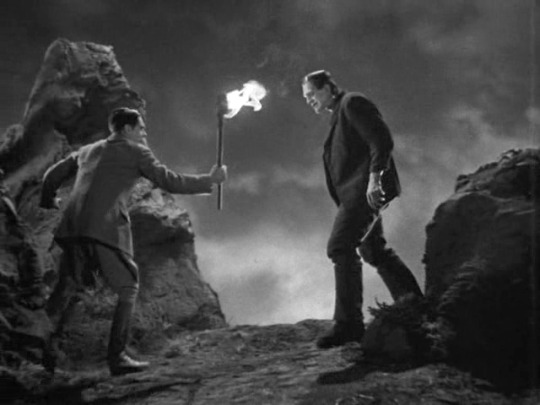
A truly great director knows to use these aspects of ‘storytelling shorthand’ well, not simply competently. Too often, directors can decide to focus the production crew, and the movie itself, in the wrong place: the trimmings instead of the tree. It’s a common problem, one that becomes more and more obvious as the range and scope for the abilities of special effects grows. Soon enough, they’ve put the plot and characters on the backburner in order to focus on the appearance of a film, and the finished project is more concerned with being a visual masterpiece than a good, compelling story.
There’s nothing wrong with being visually appetizing, but there is something important here: a balance.
In the best examples of film, visual storytelling accentuates its story, rather than overshadows it. These facets of film are used to get the film across in the most effective way possible, focusing on what is important: the story and characters.
Such is the case with James Whale’s 1931 film, Frankenstein.

Today, we’re going to be taking a look at the storytelling devices, the facts of film used by a movie crew, to answer this question:
How does Frankenstein use its movie-making tools in order to get across the story it wants to? And does it do it well, or just competently?
Let’s take a look, starting with something that may seem kind of obvious: the camerawork. (Spoilers below!)
The camerawork in a film can sometimes be the dealbreaker, or the dealmaker, depending on how it’s used. When the cinematography is done well, it’s breathtaking, when done competently, it is adequate, but when it’s done badly, you really notice. There’s a whole lot more to camerawork than just pointing it at the action. There’s a lot to consider, like setting, lighting, character placement, colors, mood of a scene, and even mood of a character. And trust me when I say that that’s not all they have to be thinking about.
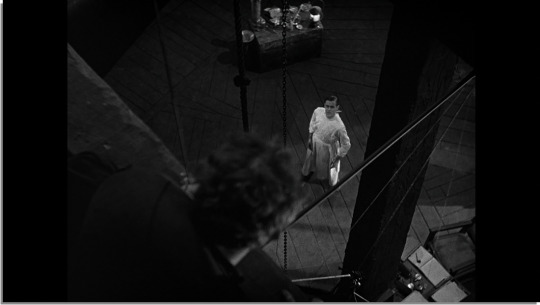
The cinematography, along with the editing of shots, is purposefully trying to get a reaction out of the audience. A good director knows how to use the camera and his crew to emphasize certain details, moods, or even subtle clues or indications of the story itself in just what the audience is looking at. The camera is not just ‘pointed at the action’, it’s used to help tell the story, while leaving a visual mark on it.
Frankenstein demonstrates this masterfully.
There are plenty of examples of striking visuals in this film, scenes like the initial pan in the graveyard, taking in the tombstones, the funeral party, and finally Henry Frankenstein and Fritz. Or the fantastic ‘raising of the monster’ scene, combining the sparking of electricity and the intense visual atmosphere to build a tension of terror, or the utterly gripping shot of Henry watching his creation’s hand move. While all of these scenes are great, unfortunately, I can’t go shot-for-shot through Frankenstein to show you all of them. (Though stay tuned for scene spotlight, a feature that’s going to do just that) What I can do is point out a few special examples.
The first one I want to bring to your attention is a weird example. It’s the scene where Elizabeth and Victor are talking about how worried they are for Henry. This doesn’t sound like it should be all that interesting, after all, we want to get to the monster, but James Whale knew where to point a camera.

Most scenes open with an establishing shot, a wide shot that lets the audience get a look at where we are so they can orient themselves and the characters in the context of the area. This scene doesn’t do that.
It opens on a series of close-ups: The framed photo of Henry, Elizabeth’s face, the door opening and Victor walking in, and only then do you get a wide shot, taking full advantage of the grand set. Until then, the audience is subconsciously working to figure out where they are, and trying to orient themselves during it. It’s a fascinating technique, one that isn’t very common, even in this movie. It’s the only time he does it.
On the other hand, something that Whale does all the time is hold the camera at a distance from the action.
See, Frankenstein was based on a book, sure, but a book that had been adapted to the stage long before movie screens. As such, early adaptations of Frankenstein tended to be, at least a little, based on the stage play. Such was the case for this film.
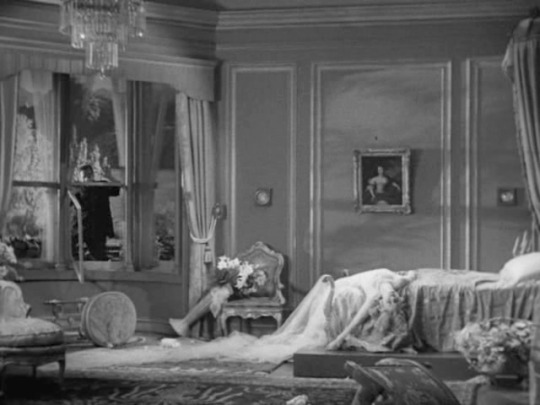
As such, the movie is shot, in many instances, like a stage play.
There isn’t a whole lot of camera movement in Frankenstein. The camera is usually set kind of far back from the action, letting the audience see the players move around the set, kind of like they would in a play. The camera doesn’t move with them, just sits back and lets the audience see what’s going on. Watch the “It’s Alive!” shot, or the scene where the creature stalks Elizabeth.
Now, that isn’t to say that the camera doesn’t move at all. There’s plenty of slow pans (the shot where the monster is raised through the roof) and close-ups (the first good look at the monster). But for the most part, the audience is shown what’s going on from a slight distance, from Fritz in the classroom to Frankenstein confronting his monster.
It’s an interesting way to view the action, and at first, it can perhaps seem like a bad idea on paper. After all, you want the audience in close, being there with it. But in practice, in the film itself, it works very well. The slowness of the movement, (aided with the total lack of soundtrack) adds to tension. Being able to see the whole thing builds suspense for characters as you see what they don’t.
That being said, there are plenty of interesting shots, especially within Frankenstein’s lab, that allow you to explore the space in interesting ways, making full use of the weird angles and shadows to maximize ‘scare factor’. Even the close up of the monster’s hand moving with Frankenstein reacting to it in the same shot is a masterful example of the camera in close, emphasizing the tension of the scene. Other shots, like seeing Fritz’s hanged body in the background or that iconic first shot of the monster on its feet are all master-classes in and of themselves in using a camera to convey a feeling, as well as the story, to an audience.
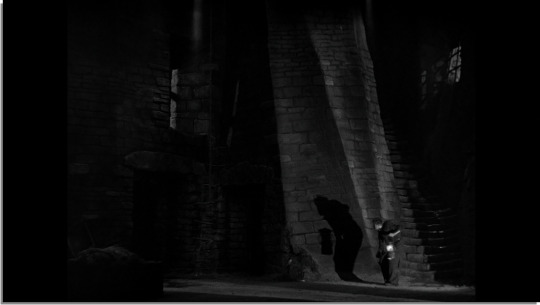
But there’s more to a film’s atmosphere than camerawork. There’s the soundtrack, as well.
Or, in this case, the lack thereof.
We’re used to most movies having a soundtrack, favorites coming from geniuses like John Williams, Danny Elfman, or James Horner, but Frankenstein has no music in it at all once the opening credits stop.
Music seems like a natural part of filmmaking, from the heroic opening of Superman to the shrieking strings of Psycho, even to the haunting score of The Thing. Music sets the mood, helping the audience feel what’s going on in the story. Especially in horror, where the idea is to unsettle the audience, the soundtrack seems essential, building up tension and scare-factor in a scene.
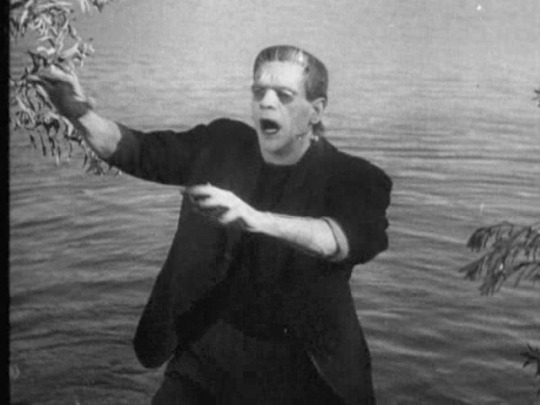
It seems odd that Frankenstein should be so totally silent.
However, it kind of works.
The silence of Frankenstein as a film works very much to the film’s advantage. You are forced to pay attention to characters and what they’re saying, true, but that’s not really a problem often faced with soundtracks. No, the benefits of the lack of music in this case are twofold, and they’re a little unusual:
1. Eerie silence works very well for this.
2. Without music cueing the audience in, it’s up to the individual viewer to determine what they think of characters.

The first point is the easiest to discuss, so let’s start there.
The only thing scarier than the creepy theme to Halloween is no theme whatsoever.
The absolute quiet in Frankenstein renders the tension harder to bear than if there had been music to cue the audience in. Hearing nothing but the thunder during the scene of the monster’s creation renders it a more vivid experience, putting the audience in the scene without background music to remind them that they’re in a movie. Even the scenes where the monster kills are more uncomfortable without music to warn us.
So yes, it’s scarier, in a way. It also forces the audience to pay more attention.
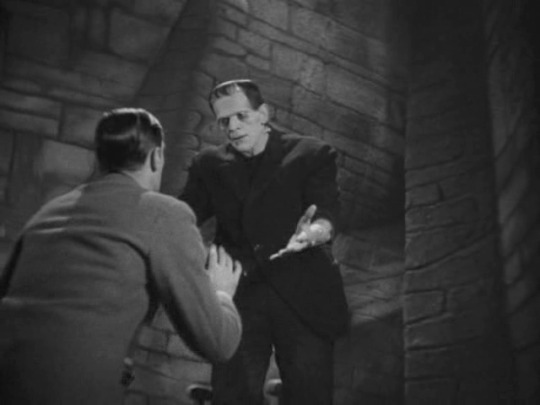
Music tells us a lot about a character or a film. It tells us that Luke Skywalker wants more, and that Darth Vader is scary. It tells us that Rocky is better for his training. It tells us that the dinosaurs in Jurassic Park are awesome.
In Frankenstein, it tells us nothing, because it’s not there at all.
The lack of musical cues for the audience forces them to pay attention and think about what is happening. Are we supposed to be scared? Sympathetic? Both? Neither? It’s hard to tell what music would play over the monster after he accidentally drowns Maria, or after Henry survives the climax at the windmill. In that, it’s up to the audience to interpret whether these things are meant to be seen as good or bad In that, somehow, a lack thereof still allows a soundtrack to do what it does best: accentuate the audience’s experience.
This ambiguity, also present in how the film is shot, allows this film to stand so firmly so many years later: it never gives you a thorough answer over what to think about what’s going on. For all its differences with the book, it does have one thing in common with it: it extends questions for you to answer, without providing much of its own. It’s on you to decide what to think.

Even though there wasn’t any music, there was a whole lot of something else: sets.
The setwork in Frankenstein is massive, hugely expansive atmospheres and locations for the audience to marvel at, and more importantly, be unsettled by. Shades of this scope appear later in things like Edward Scissorhands (albeit with a classic Tim Burton twist) and other horror-inspired films and shows, from the thunder-and-lightning surrounded tower to the interior of the lab.
James Whale shot sets in a grand way, letting the audience experience the grandiose scale of each individual location. From the huge Frankenstein mansion to the interior of the mad-scientist lab, to the cemetery, even to the burning windmill, each setting feels larger-than-life, giving the gothic set-design an even better chance to shine. The Frankenstein manor feels appropriately impressive, bright and safe, with shots that emphasize the scope of the luxury and the various rooms inside. The mill feels dangerous, dark and cramped, with too many obstacles.
But of course, the set that everyone remembers is the Frankenstein lab, and with good reason.

The tower, the stone walls, the electric gadgets and gizmos all going off together, the operating table, beakers galore, levers, control panels, and an open ceiling to raise the monster, now this is a mad-scientist laboratory.
Originally created in 1927 silent film Metropolis but codified forever in Frankenstein, James Whale knew how to shoot this set. Loosely based originally on the labs of Nikola Tesla, the lab of Dr. Frankenstein is so iconic that it’s been recreated (or re-used) in everything from straight horror films or loving spoofs like Young Frankenstein. Whale allows this place to feel unsettling, scary, helped enormously by Colin Clive’s crazed and uncomfortable performance as Henry Frankenstein. The lab, much like most of the sets in the film, is full of dark shadows, of stark contrasts, feeling intentionally scary.
Every set in this film is shot with plenty of shadow and darkness, allowing the audience to really feel uneasy. But the sets aren’t the only thing that are adding to the scare-factor. Also helping out drastically in these scenes is the special-effects department.
Long before the invention of CGI, monsters had to be created in the makeup chair. The original looks what’s considered the ‘classic’ monsters were created through layers of makeup and prosthetics, from Dracula’s fangs to the Wolfman’s animal face. The Frankenstein monster was no different.
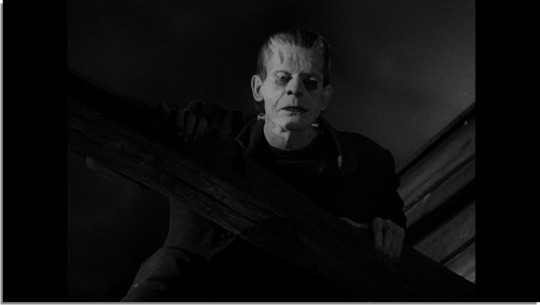
The appearance of the monster could possibly be considered as the greatest special effect this film has to offer. The heavy lids, hollow features, electrodes and flat-topped head are all iconic visuals that continue into modern pop culture, and with good reason.
The effect of the original Frankenstein makeup was stunning, and instantly memorable. For a film made in 1931, the makeup on the original monster looks incredible, standing the test of time almost ninety years later. It remains a convincing effect, giving the creature a distinct, undead look that is incredibly striking.
But the visual look of the monster wouldn’t mean much of anything if it was just a makeup job. There has to be something there behind the makeup that makes it really work: the performance of the actor underneath.
Thankfully, Boris Karloff was more than up to the task.

See, no matter how good the cinematography, sets, or makeup, Frankenstein would be nothing if not for the final, essential ingredient: the performances.
And it is here that the movie goes from good to great.
As I’ve mentioned before, Frankenstein has no ‘small’ performances. Everyone in this film brings huge energy to each role, and no one more so than the monster himself, Boris Karloff.

Karloff manages an incredible range of expression through the heavy monster makeup, bringing out the monster’s innocent initial nature perfectly. He is able to portray the gambit of emotions, from fear to rage, to curiosity, to joy. It is Karloff’s performance that turns the monster into a creature that the audience sympathizes with, to the point that even when he is acting ‘monstrous’, it’s hard to forget his childlike happiness at playing with Maria. Karloff’s abilities as an actor force the audience to contend with the monster’s humanity, and his expression through the ‘dead’ makeup and heavy eyelids is as incredible as it is compelling. For one specific example, the scene where the creature is first exposed to light is a classic scene, that remains moving and powerful no matter how many times you see the film. Karloff’s performance is that of a confused creature, just learning about the world and finding it a harsh and dark place.

Colin Clive as Henry Frankenstein brings manic energy to his character in the first half, and regretful sobriety in the second. He is the perfect quintessential mad scientist, howling about his accomplishments and seeing nothing wrong with stealing bodies to stitch together to create life, until he realizes his mistake. Frankenstein’s transformation and breakdown is rendered believable and interesting through Clive’s incredible performance as the regretful scientist, determined to right his wrong after the monster runs loose. His switch from the emotionally-distant scientist to a man concerned with his friends and family is dramatic but understandable, and the audience buys his uncertainty just as much as they buy his mad ambition.
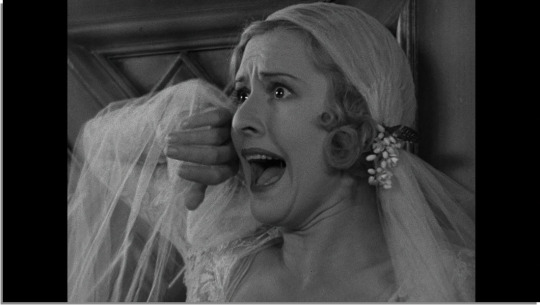
Mae Clarke’s showing as Elizabeth, despite not getting much in screen time or dialogue, manages to portray a woman trying to remain strong despite her fiance’s increasingly weird behavior and the undead-goings-on surrounding her wedding. She’s worried, but she’s also in love, and doesn’t want to leave Henry, despite the things he’s done.

Dwight Frye as Fritz is the quintessential Igor, the hunchback assistant that we now associate so strongly with the story. He’s a nasty being, mean-spirited and is ultimately the person most likely responsible for the creature’s bad streak of luck. A bully without scruples, Fritz helps Frankenstein assemble his equipment and parts, and eventually dies at the hands of the monster, managing to remain entirely unsympathetic the entire time, which seemed to be rather the point.
Edward Van Sloan’s portrayal is that of a perfectly ‘reasonable’ scientist, an old man accustomed to the ways of science. His concern is completely understandable, and he comes across exactly as he should: the opposite of Victor, entirely on the side of caution. Unfortunately, his caution also leads to the decision of killing the monster, but Van Sloan portrays this not so much as lack of humanity, but lack of empathy and understanding that he is also dealing with ‘humanity’. He is not a villain, but he isn’t really considering the whole picture here.
It is in these elements that Frankenstein truly becomes ‘immortal’
A film can have a great script, fantastic characters, and even great sets, cinematography and makeup, but it is in these incredible, vivid, vibrant performances that the film goes from good to great. Without the sympathetic monster, the manic mad scientist, or even the crooked (in more ways than one) lab assistant, Frankenstein as a film would be just another one of the many incarnations of the story. It is thanks to all of these facets of film that Frankenstein excels, going beyond simple ‘monster movie’ to horror classic.
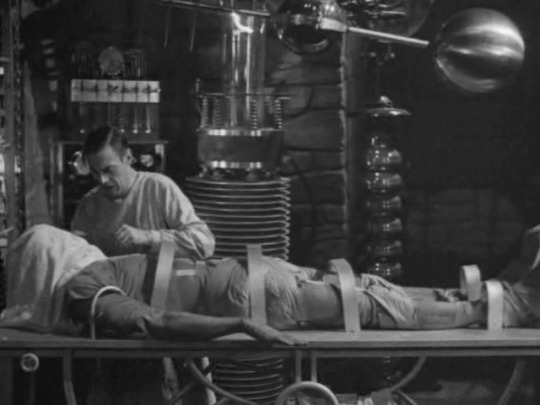
Everything in this film is perfectly crafted for the specific needs of the screenplay. Every inch is designed to bring this spooky story to life, without forgoing depth of either the shadows or the characters. From the sets and the camerawork to the work of the actors themselves, everything in Frankenstein fits together perfectly, a horror classic, but also simply a film classic, a landmark that definitely deserves its place in Hollywood History as one of the greatest films of all time.
James Whale and his crew certainly knew what they were doing. Every facet of film, from the camerawork to the performances, demonstrating every mood and feeling without having to explain it. The sets and characters feel perfectly realized, gothic, creepy, and compelling, setting the mood for the thrills and chills story.
Full of scares and screams, Frankenstein’s facets of film come together to convey a great tone, characters, and story, and in the end, that’s exactly what they’re supposed to do.
Thanks so much for reading, and I hope to see you in the next article.
#Film#Movies#Frankenstein#Frankenstein 1931#1931#30s#Horror#Drama#Sci-Fi#Science Fiction#PG#Boris Karloff#Colin Clive#Mae Clarke#Dwight Frye#Edward Van Sloan#James Whale
5 notes
·
View notes
Text
Daenerys Targaryen is the main character of GoT… by accident
(Credit where credit is due: I am building on meta I’ve seen floating around fandom in other places)
Game of Thrones is now Daenerys’ story. Before S8, GoT arguably had three main characters: Dany, Jon, and Tyrion. But S8 retroactively changes that and the story is now Dany’s and Dany’s alone.
Every single character (with one exception I’ll get to later) who survives to S8 has their entire narratives and character arcs hijacked and redirected into serving Dany’s narrative. Everyone and everything is diverted into maneuvering Dany to her end point. The entire overarching story, and all the characters’ individual stories that comprise it, warps and bends itself completely out of shape in service to the Mad Queen reveal.
Jon’s parentage and Targaryen heritage are only relevant because of how they impact Dany’s arc and mental state. The Long Night must precede the fall of King’s Landing because Jorah must die in order to further weaken Dany’s mental stability and further isolate her from “good” advice, and also to put her and her forces in a generally more vulnerable position. Arya kills the Night King try to undermine Dany’s status as the Savior and minimize Dany’s importance to the North. Sansa mistrusts and hates Dany for no reason other than feeding the conflict between Dany and the North, while feeding into Dany’s own trust issues and paranoia. Jaime can’t get redemption because a character we care about has to die in the King’s Landing firestorm doing something “noble” (i.e. protecting his sister-lover). The travesty that is the characterization of Varys and Tyrion is solely in the service of the Mad Queen narrative (there’s more than enough meta on that already in existence, I don’t feel the need to add much to it).
The whole entire story warps around Dany’s supposed villain arc. Every character has their individual arc trajectories, which had been painstakingly laid out over seven seasons, completely dismantled and reassembled with only one goal: Dany’s demise. Every characters’ story is now subordinate to Dany’s.
This also means that since the end of all these characters’ narratives is the sole purpose of bringing about Dany’s death, this retroactively means that their arcs in their entirety, across the whole eight seasons of GoT’s run, are now about Dany. Making Daenerys Targaryen the sole main character of Game of Thrones, because she is the epicenter that the entire narrative revolves around.
And the best part is that this was done completely by accident and through the sheer incompetence of the showrunners. They were so desperate to vilify Dany and had also imposed such a strict and completely artificial time constraint on themselves, that they had to wreck their whole story to make it happen and as an (I’m very confident) unforeseen consequence the whole story is now about Dany and no one else.
This is why, in the last half of the final episode after Dany’s death, the show and all its characters feel strangely and suddenly…rudderless. The whole reason for being of the show and every last one of its surviving characters is dead, taking all the heart and the meaning with her, and now we’re stuck watching a bunch of characters just kinda jangling pointlessly around inside an empty, vacuous narrative devoid of meaning.
That’s why the second half of the finale feels so odd and it’s so difficult to stay engaged with it, and ultimately its why the ending Stark Victory Montage falls incredibly flat, ringing absolutely hollow despite Ramin Djawadi’s best musical efforts to try and force the audience to feel something--or just anything at this point.
And so, that is how D&D, in their petty small-minded zeal to destroy a female character whose religious imagery and savior narrative had spun wildly out of their control making her more popular than their white male faves, accidentally made Daenerys Targaryen the main character of their show, while they were actually trying to vilify and discard her like garbage, in a twist of dramatic irony.
They also retroactively made Dany a tragically maligned messianic figure, because they utterly failed to actually vilify her or make her the Mad Queen. They worked so hard to make every character around her incessantly talk about nothing but her madness, bending every character to serving her narrative, but then “kinda forgot” to write her as Actually Mad. All they succeeded in doing is painting her as a ruthless military commander who mercilessly refuses to accept an enemy’s surrender, which sure, is morally yikes, but is not a sign of actual madness.
A great example of just how bad this laziness in the writing gets is the way D&D use quasi-nazi-esque imagery to hurriedly frame Dany as Evil in the last episode, but don’t actually fill that imagery with content to match. Dany isn’t proposing racial cleansing (stop calling the destruction of King’s Landing genocide, omfg. Words mean things. And destroying a city =/= attempting to wipe out an entire race. Get off my lawn) or presenting the Unsullied or Dothraki (or herself an a Valyrian) as the Master Race; she’s not spewing nazi propaganda. She’s talking about conquering the world, but many leaders throughout history have had that goal, and they weren’t nazis by default. But D&D still use that cheap visual shorthand to try and quickly prejudice the audience against Dany, because they “kinda forgot” to write her an actual villain arc.
So, not only is everything now about her, but Dany is now a tragic failed messianic figure, Jon is now her Judas who literally betrays her with a kiss, and she is murdered by characters and a narrative that have framed her as Mad while in actual fact she is not. So, not only is this now The Story of Daenerys Targaryen, it is specifically The Tragedy of Daenerys Targaryen. By accident.
Now, for that one exception I of spoke of earlier. The only character in S8 to not have their whole arc hijacked in service to Dany’s tragedy, and the reason Cleganebowl is so satisfying, is Sandor Clegane. His arc remains purely his own and he remains on the trajectory he had been on since the beginning.
Complaints that S8 “throws out Sandor’s character development,” opining that S6 was somehow about “redeeming” him from his vengeance quest, must be from people who…didn’t actually watch S6.
Sure, the Hound encounters a septon (I refuse to call him Meribald) with whom he forms a fledgling bond, and this septon opines that “violence is a disease” and “you don’t cure a disease by giving it to more people,” sure. But then when the guy is murdered by rogues from the Brotherhood, Sandor immediately picks up an axe, tracks them all down, and murders them gruesomely in an act of vengeance, effectively spreading the disease of violence to yet more people.
This ain’t a guy who just turned away from his path of vengeance; this is a guy who’s just reestablished that vengeance is his whole entire arc. S7 also supports this, by having Sandor confront his brother in the Dragon Pit and declare, “You know who’s coming for you. You’ve always known.”
So, S8 Cleganebowl was not “out of nowhere” and was completely in keeping with where Sandor, on the show, was always headed.
Sandor Clegane’s arc remains his own in S8, he’s never sidetracked by hand-wringing about Dany’s “madness” or plotting Dany’s downfall, and he remains on the track he has always been on, which is why his arc resolution is so satisfying (even if we can debate the morality or thematic soundness/faithfulness to the books’ anti-vengeance themes). Although he does die in Dany’s firestorm at King’s Landing, which fire he and his brother burn in is arbitrary. Sandor Clegane is the only character with an arc that stays clear of Dany’s blast radius.
Literally every other characters’ arc gets caught in that blast radius, which is why Dany takes down not only the entire show but all of its characters (save one) with her, and retroactively becomes its main character.
522 notes
·
View notes
Text
Writing Craft: The Complete Handbook of Novel Writing Ch2
AO3 Intro Previous
The Complete Handbook of Novel Writing
Chapter 2: Mastering Fiction’s First Rule by Jack M. Bickham
Okay so this is an article on ‘Show, don’t tell’. I hate this subject and not just because I’m bad at it. No one explains it the same way and a lot of what most authors do say is subjective. So what I’m going to do is try to summarize this author’s advice and then add on other pieces of advice I’ve found useful.
Alright so this is verbatim from the book pg 12:
The phrase “Show, don’t tell” is shorthand for this advice: “Don’t lecture your reader: she won’t believe you. Give her the story action, character thoughts, feelings, and sense impressions as the character would experience them in real life. Let her live the story for herself as she lives real life, by experience.”
Maybe this will help someone else but it’s got two glaring problems for me. First it’s still vague and yes he does go deeper in the article but I think most people have heard some form of this before. Second, it assumes that people experience things the same way and we don’t. If you’ve read any of my writing it’s obvious I’m not a visual person. I don’t describe settings or character’s physical appearance unless I have to and then as sparsely as possible. Why? Because that’s how I experience life especially in books I form a mental representation of a character in my head, not a physical one and it shows. However I know that other people want the visual, some even need it to connect with the character. So advice that I think is more helpful is to use the five senses. Again this is not my strong suit so I’ll try to get as much advice from other sources tagged onto the end as possible.
From Facts to Feelings
In this section the author explains that school and most work environments do not prepare you for creative writing. You’re expected to give facts without embellishment and with as little personality as possible. You’re there to relay information not entertain. Writing stories on the other hand you absolutely don’t want to lecture your readers.
“Fiction can only involve and convince and excite readers if it lets them experience the story world the way they experience real life: By taking in stimuli and drawing their own conclusions.” (pg 13)
This right here is what I have a hard time with. Partly because I’m afraid I won’t be able to give readers the correct stimuli to form the conclusion I’m going for and partly because it’s so much simpler to allow whatever character I’m writing to give their assumptions and opinions than really go into too much detail. Some people will call me lazy for that, but it’s more than I just never learned how to do it any other way.
The author illustrates his advice with an example saying that you don’t list off facts when you’re observing something, you observe with your senses, which is true.
First part of example:
“Cloud cover is thick. The temperature is 64 degrees, the humidity is 42 percent, traffic on the highway is heavy, it’s late September, the postman is irritable today.” (pg 13)
Second part of example:
“What you do is walk outside and see with your eyes that it’s gray and dim; you look up and see thick gray clouds; you feel the temperature with your skin … and relax, or feel warm, or shiver. If you breathe deeply and the air feels thick to you, you may conclude it’s humid. You hear the roar of cars nearby and conclude traffic is heavy on the highway. You see the postman coming up your driveway. Your eyes meet and you smile at him. His mouth turns down, his eyes squint and he glares silently back at you. You conclude he is feeling grumpy.” (pg 13)
I get what the author is trying to do, really I do, but at the same time there’s so much more you have to think about when adding details like this. However this can be a decent starting point to help you think about why you come to the conclusions you do rather than just focusing on those conclusions. Most of the time we aren’t consciously aware of the input our system receives so it can be difficult to break things down this way. My only advice is to study resources on description and body language and try to take some time to really focus on your surroundings when you can. Also try and focus on the things you don’t notice normally. For me that’s anything visual, for you it may be sound or smells.
Get Into Viewpoint -- And Stay There!
“The process of showing, not telling, can be broken down into four essential steps. They are:
Selection of, and adherence to, a single character’s viewpoint
Imagining the crucial sense or thought impressions that a character is experiencing at any given moment
Presenting those impressions as vividly and briefly as possible
Giving those impressions to readers in a logical order” (Pg 14)
And this is the point where it’s impossible for me to be objective. If this seems to make sense to you feel free to message me and I’ll take pictures of the article and send it to you so you can read it in full. As for me, this author makes far too many assumptions and takes to simplistic a view on writing as a whole for it to be of any use to me. The viewpoint thing especially bothers me because I can tell just as much from one character’s head as I can head hopping.
Divining the Dominant Impression
This for me is the only useful part of this article and it boils down to this; in order to show and not tell, and be as concise as possible, focus on the dominant sense. When you walk into a new environment what is the first thing you notice? Well it depends on the environment. If you walk outside and there’s road construction going on chances are it’s the sound. Walking into a bakery it’ll likely be the smell. Yes you want to use details from other senses to flesh it out, but it’s a lot easier to focus on one thing at a time.
Revealing Characters
This section basically tells you to use character actions to show their personalities rather than using the conclusions you make from those actions. It’s the difference between:
Carmen was sad
And
Carmen’s shoulders were slumped and she had tears in her eyes.
It’s good advice and another reason to study body language. Again, try to focus on the important part. If you’re trying to get across a character's anger you don’t need to describe his hair. Pick and choose what’s important at the moment.
When to “Tell”
“The data are objective and absolutely essential to reader understanding.
The factual information is so fascinating that it may “sell” the story. (This is very rare.)
The point is quite minor and we can risk “cheating.”
Economy of words is vital at the moment.” (pg 18)
Again this is overly simplistic and assumes a specific writing style.
That’s it for this chapter and because I know I suck at this part of writing…
Other articles on Show, Don’t Tell
https://jerryjenkins.com/show-dont-tell/
https://blog.reedsy.com/show-dont-tell/
https://self-publishingschool.com/show-dont-tell-writing/
https://jerichowriters.com/show-dont-tell/
https://writingcooperative.com/my-golden-rules-to-show-dont-tell-f4d030eca8c9
And you can google others. Most of these say about the same thing but everyone is different and seeing things worded just a little differently can make all the difference on whether you can understand and apply it to your own writing.
The third link down is my top pick because it not only gives examples but practical advice to find places in your own writing where you can improve.
Again, I apologize for the less than stellar summary but I honestly can’t stand the way the author handled this subject.
AO3 Intro Previous
Ko-Fi
Tag List
@magica-est-in-aerem @18-fandoms-unite-08 @xxxshinx @whatsupwithjinx @krispydefendorpolice @corabeth11 @claaydoh @dramatic-squirrel @novicevoice @mariae2900 @rebecarojas07
39 notes
·
View notes